

Rewards Case Study: Starbucks Rewards
Starbucks is a staple coffee brand with more than 32,000 locations in over 80 countries around the world. It’s safe to say Starbucks has an abundance of loyal customers. The iconic brand has revolutionized the coffee industry and changed the way everyone consumes coffee. Starbucks took something that had been done the same way for decades and turned it upside down with effective partnerships, beautiful branding, and a variety of types of coffee drinks. They have been doing things differently ever since, including customer loyalty.
Starbucks Rewards is often regarded as one of the best retail loyalty programs in existence and one of the most engaged among its members. According to a CNN report, by October 2022, there were 28.7 million active Starbucks reward members. Giving Starbucks a 16% year-over-year growth in its loyalty program.
They have created a loyal following of customers both with their customer experience and revolutionary rewards program. But recent changes to its loyalty program have its members criticizing the new changes. It’s now going to cost more to earn that free drink and menu item, meaning customers will have to work harder to earn those stars.
Let’s dive into what makes Starbucks Rewards unique and what we can learn from its recent changes in loyalty.
Changes no one asked for
Starbucks Rewards has over 28.7 million active reward members and with new changes to its rewards program that went into effect last month in February, customers were not happy. Starbucks increased the amount of “stars” (loyalty points) customers will need to redeem items.
Here is the breakdown of what changed:
- What costs 50 stars increased to 100 stars.
- What costs 150 stars increased to 200 stars.
- What costs 200 stars increased to 300 stars.
- Hot coffee or tea, baked goods, and packaged snacks will be 100 stars, up from 50.
- Lattes, frappuccinos, parfaits, and hot breakfast items will be 200 stars, up from 150.
- Sandwiches, salads, and protein boxes are 300 stars, up from 200.
Currently, Starbucks reward members can earn 1 star per every dollar spent if members just pay with a credit, debit card, or cash in-store or pay in-app. Members can earn 2 stars per dollar if they preload money into their rewards account or register a gift card to pay with.
Idk if anybody told y’all BUT @Starbucks made their rewards about 50 stars more to redeem. It sucks a lot. What used to be 50 stars is now 100. Lol now I don’t even want to use them. 🥹 — AshCash ✌🏾 (@TechBaeAsh) February 16, 2023
With the recent changes, that free iced coffee or chocolate croissant will cost a bit more, $100 to be exact if you’re paying with cash or a debit card or $50 if you preload money in your account. To earn that free cold brew or a breakfast sandwich, you will have to spend $200 if you’re paying in cash or $100 if you preload your account.
The reason for the change is unclear if it's because of inflation or the rising cost of products everywhere. According to an Axios report, Starbucks said it was due to the changing needs of customers. “We occasionally need to make changes to ensure the long-term sustainability of the Starbucks Rewards program and to meet the changing needs of our members.” Members will disagree.
Starbucks really moved the reward levels back……..in this economy — Jobe Bean Bryant (@jeauxdeci) February 27, 2023
How Starbucks Rewards misses the mark
Starbucks Rewards is one of the best examples of customer loyalty and how to build a brand community. Based on its recent changes and the reactions from customers, there are a few ways Starbucks Rewards misses the mark.
1. Changes no one wanted
Why change something when it’s not broken? Starbucks customers have tweeted, commented, and made dozens of TikTok videos on the unwanted changes Starbucks made to its reward program.
Customers were given a few weeks' notice of these changes, which left many to have to use all of their points before changes went into effect. Starbucks really missed the mark here because so many customers voiced their dissatisfaction with the recent changes and Starbucks did not relent and went ahead with their changes.
@maddykim16 #greenscreen starbucks is a scam!! #starbucks #stars ♬ original sound - Maddy Kim
2. Current tiers don't create exclusivity
Tiered programs are an amazing way to encourage customers to spend more and engage more. Tiers challenge customers to reach the next level while also introducing an element of gamification that customers love. Tiers are also effective when the highest tier is reserved for only the most loyal and profitable customer.
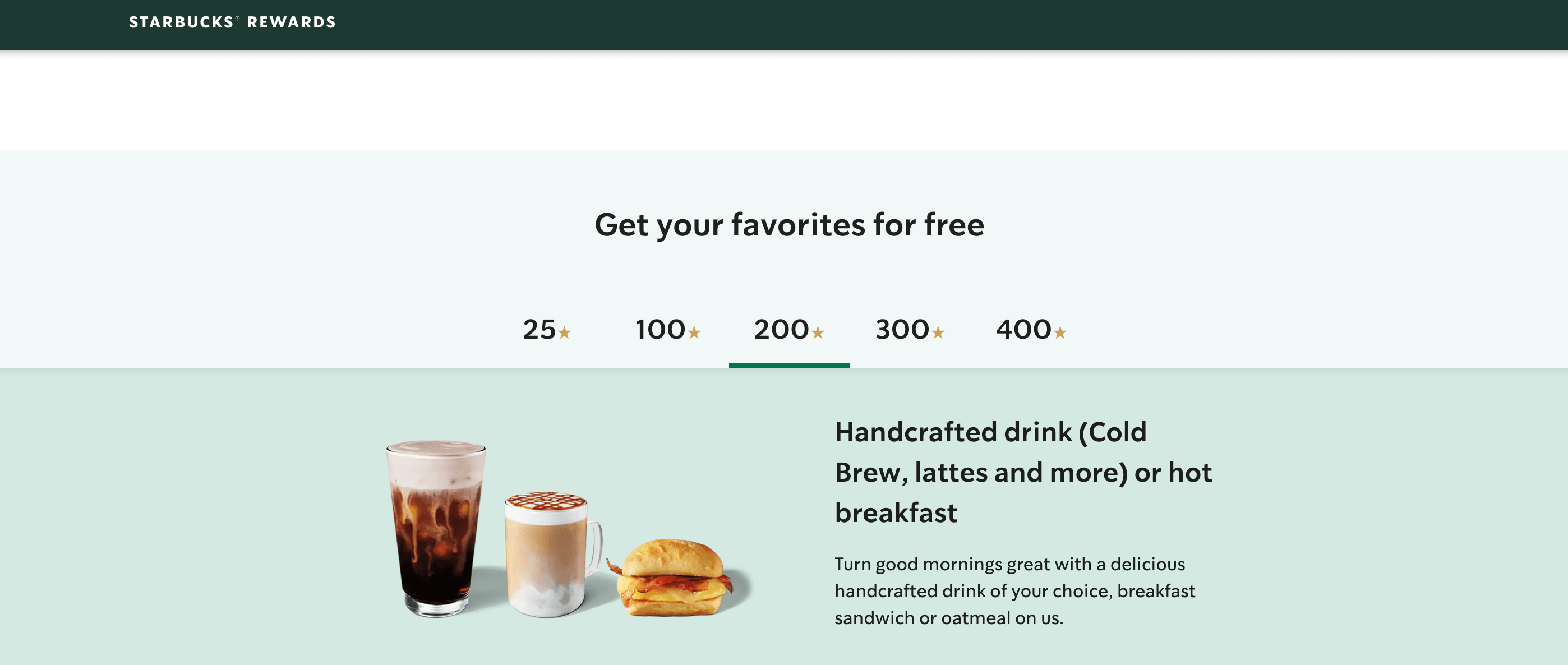
Starbucks currently has five tiers of different rewards customers can redeem. If Starbucks turned those five tiers into different levels of earnings, meaning each level would double the points earned, it would incentivize customers to spend more to enter and remain in a certain tier. Customers love an incentive or something to reach for and if Starbucks brought their famous gold card back, this would be a perfect way to entice customers into different tiers for their reward program.
How Starbucks Rewards raises the bar-ista
For a loyalty program contributing 55% of the company’s revenue, Starbucks has clearly locked in loyalty and a brand community. With an increase in prices in every industry, loyalty has become a key to growth and recession-proof for Starbucks. So what is Starbucks Rewards doing so well?
1. Outstanding mobile experience
Starbucks has become a global brand worth billions of dollars and we can take lessons on what great things they do in loyalty and rewards. Their top quality is their outstanding mobile experience.
How a customer interacts with a loyalty program can often make or break that program. Starbucks’ app makes its loyalty program more interactive and more effective. The app makes it easy to see how many “stars” (points) you currently have, as well as make orders and payments right from your phone. You can even use the service to find the nearest Starbucks location.
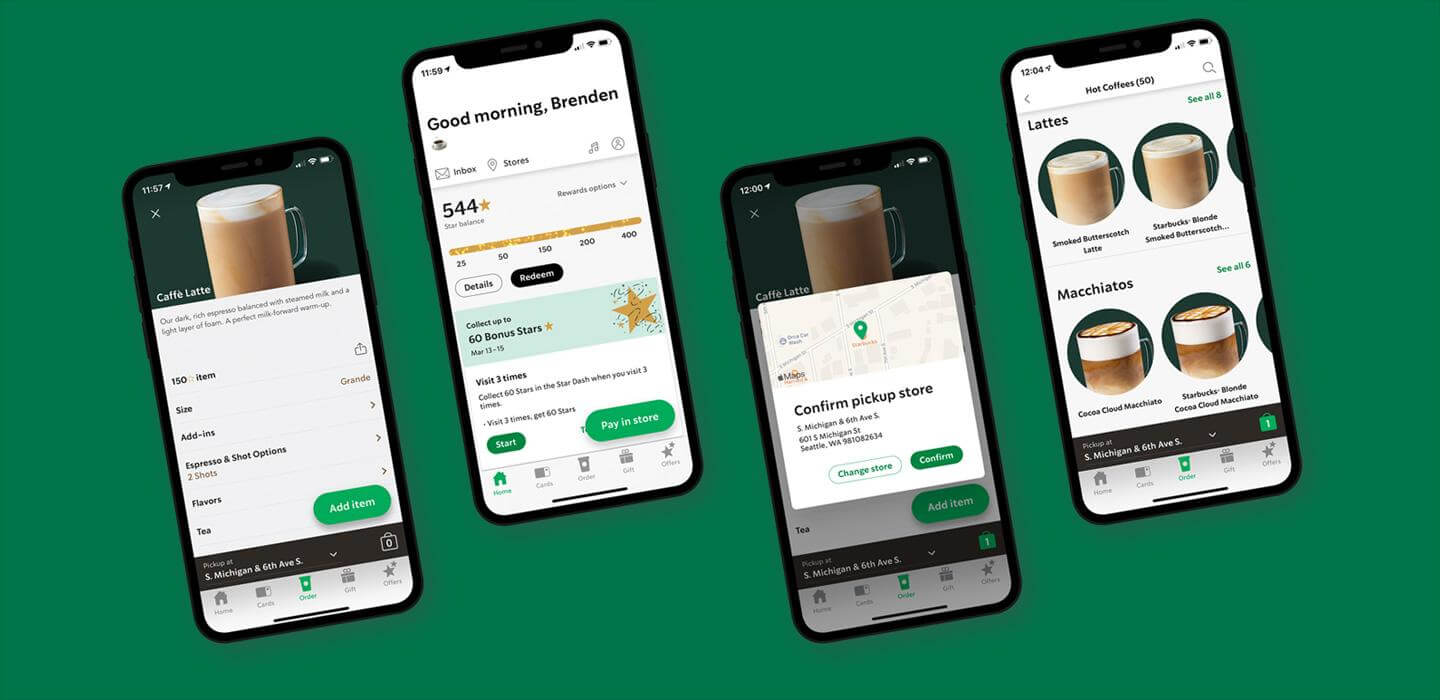
Starbucks mobile app, drive-thru, and deliveries generate over two-thirds of orders and up to 26% of sales from mobile apps alone. The app gives Starbucks Rewards an edge that other standard loyalty programs do not have. In today’s competitive environment, just having a loyalty program is not enough. You have to make an effort to differentiate your program from others.
2. Omnichannel retail
This leads to the second top quality of Starbucks Rewards and that is their omnichannel presence throughout the apps and physical retail locations and across their marketing. Not only can you pay on a mobile device or through in-store locations, but you can also shop online, order drinks through the app, or have an experience visiting different locations in any country. You know what you will get no matter where you are in the world.
From the rise of new services such as BOPIS (buy online, pickup in-store) to the conveniences of ordering from an app. Surprisingly, how we collect and receive our purchases are also different. Starbucks has expanded into delivery through its partnership with DoorDash which it tested in California, Florida, Texas, and Georgia last fall.
3. Experimenting with partnerships
The third top quality and characteristic of Starbucks Rewards are its partnerships. Starbucks has recently been experimenting with new partnerships in loyalty programs, going a step further with established brand partnerships. After testing its delivery partnership with DoorDash , Starbucks will expand nationwide in all 50 states by March 2023.
View this post on Instagram A post shared by Starbucks Coffee ☕ (@starbucks)
Starbucks is expanding into the NFT market with its program Odyssey. According to Starbucks, ”selected participants will be able to engage in Starbucks Odyssey ‘Journeys’ which are a series of entertaining, interactive activities to earn collectible ‘Journey Stamps’ (NFTs) and Odyssey Points that will unlock access to exciting new benefits and experiences.”
View this post on Instagram A post shared by Delta Air Lines (@delta)
What’s better than one loyalty program? How about two loyalty programs? For those frequent travelers, Starbucks and Delta announced a partnership where members can link both of their loyalty programs and earn points. “Link your Delta SkyMiles and Starbucks Rewards accounts to start earning 1 mile per $1 spent at Starbucks.” This is another way Starbucks can in a way gamify their loyalty program, while also offering more to its customers.
Gold Stars for Starbucks Rewards
With almost 30 million program members, Starbucks Rewards is a top standard for loyalty programs that any ecommerce business can take lessons from and be on their way to replicating. Whether it's building an awesome omnichannel strategy or delivering a fantastic mobile experience or partnering with other brands in your industry, Starbucks can deliver lessons to all of us.
Editor’s Note: This post was originally published on July 24, 2017 and was updated for accuracy and comprehensiveness on March 13, 2023.
You might also like

How Monos Unlocked $8M with their Loyalty Retention Strategy
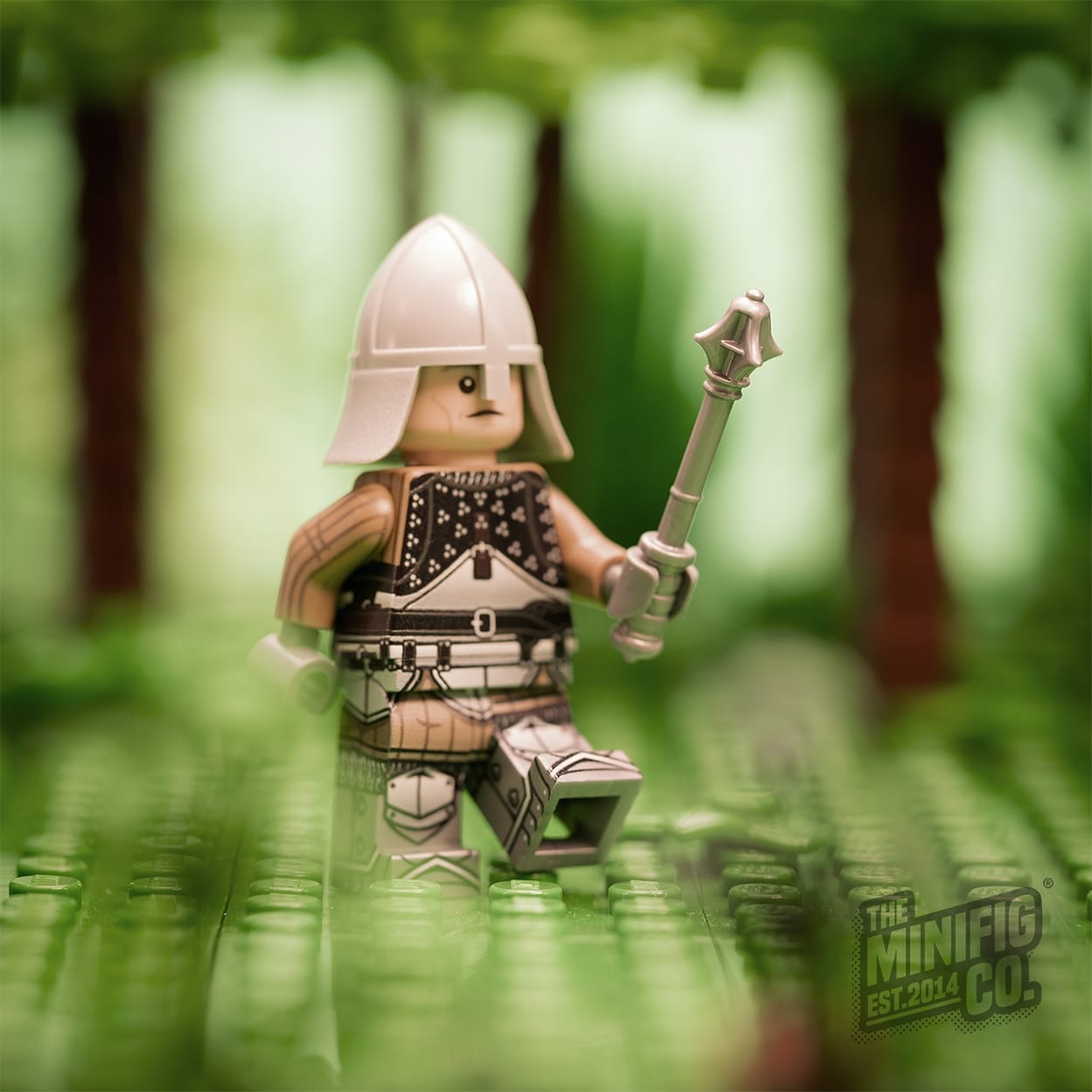
How The Minifig Co. Uses Embedded Loyalty to Drive Sales

Rewards Case Study: PetSmart Treats Rewards (+How to Recreate the Program)
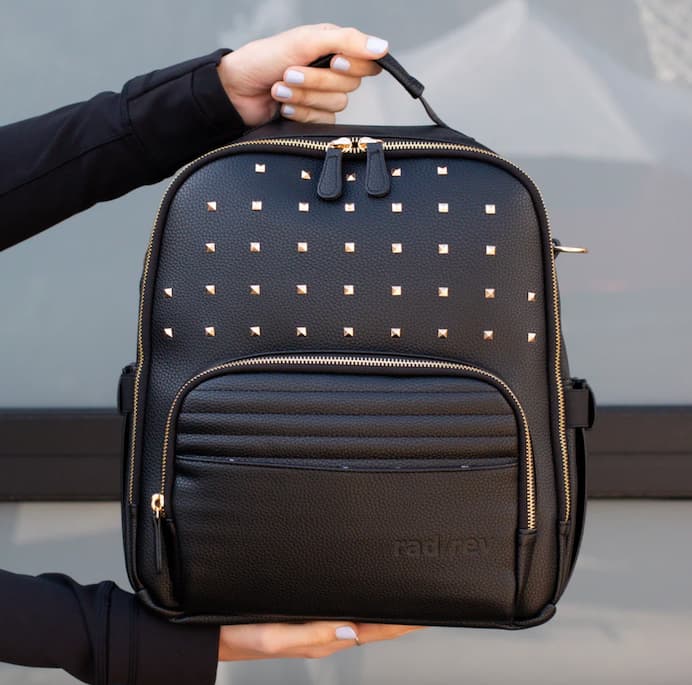
How Rewards Influenced $200K+ in 1 Year for Rad Rev
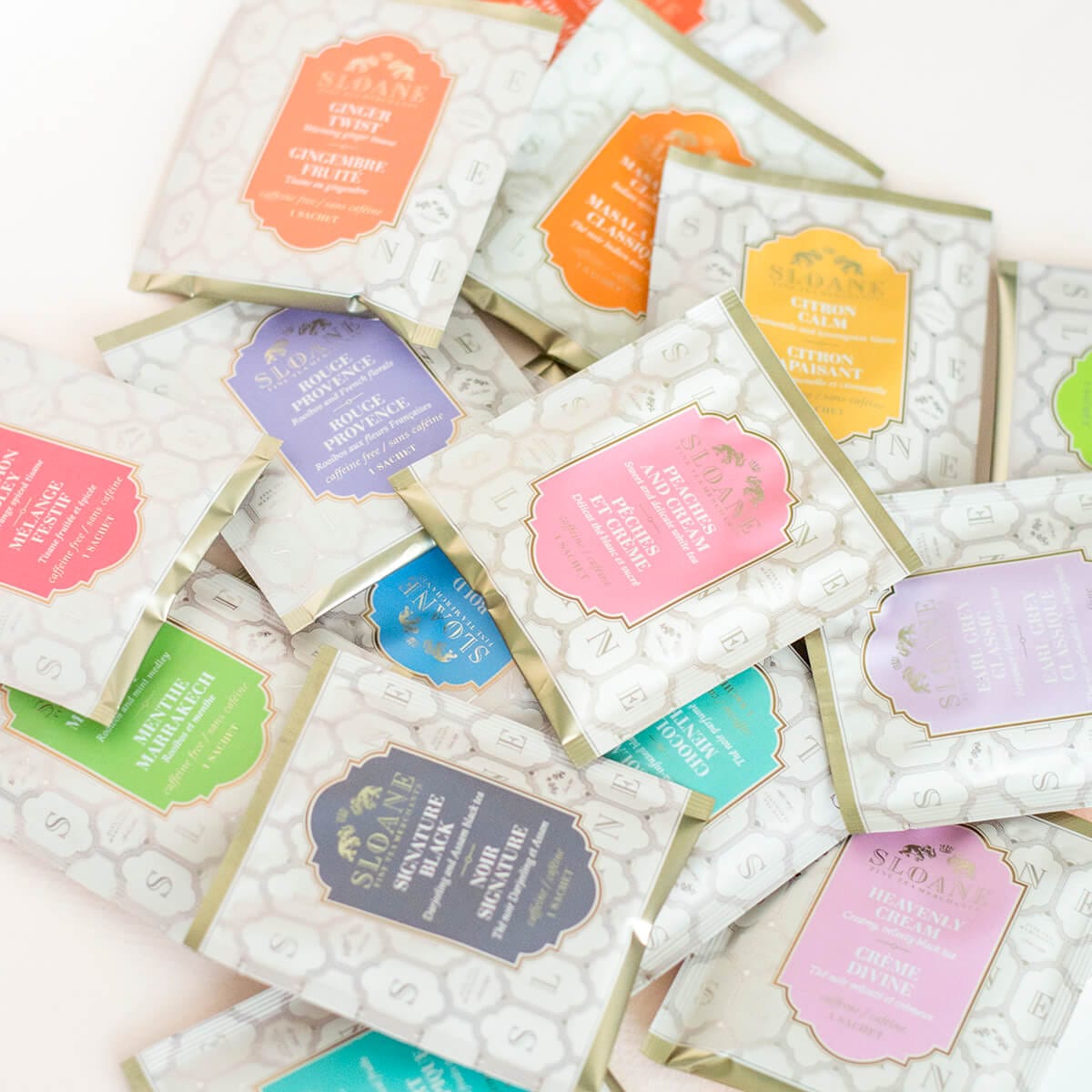
How Sloane Tea Boosted Revenue by 370% in 24 Hours with Bonus Points
Subscribe to the smile newsletter.
- Request a demo
- Contact sales
- Start free trial
Starbucks Loyalty Program Case Study

Starbucks, renowned as one of the foremost coffee brands globally, owes its success not just to its exceptional range of products. A significant contributor to its widespread acclaim is its highly popular loyalty program , which has been an inspiration for many U.S. restaurant chains and retail stores. Launched on December 26th, 2009, the Starbucks rewards program has amassed over 30 million active members, contributing to nearly 60% of the brand's total revenue. The program effectiveness was strikingly evident in 2019, with Starbucks reporting a substantial 7% increase in sales primarily attributed to the efficacy of its rewards program.
Program type
Points system.
- Points for rewards
- Coalition Loyalty
Starbucks Rewards leverages a points-based system ingeniously designed to enhance customer engagement and loyalty. Members accumulate 'Stars' with each purchase made via their registered Starbucks Card or through the Starbucks mobile app. The program is structured to encourage varied forms of engagement, enhancing the overall customer experience and brand loyalty.
- Earn 1 Star per $1 spent when you pay in cash
- Earn 2 Stars per $1 spent when you preload your digital Starbucks Card
- Earn additional bonus Stars through special promotions
- Earn double Stars on Delta Airlines travel days
- Earn double Stars on promotional days
- Points expire after 6 months
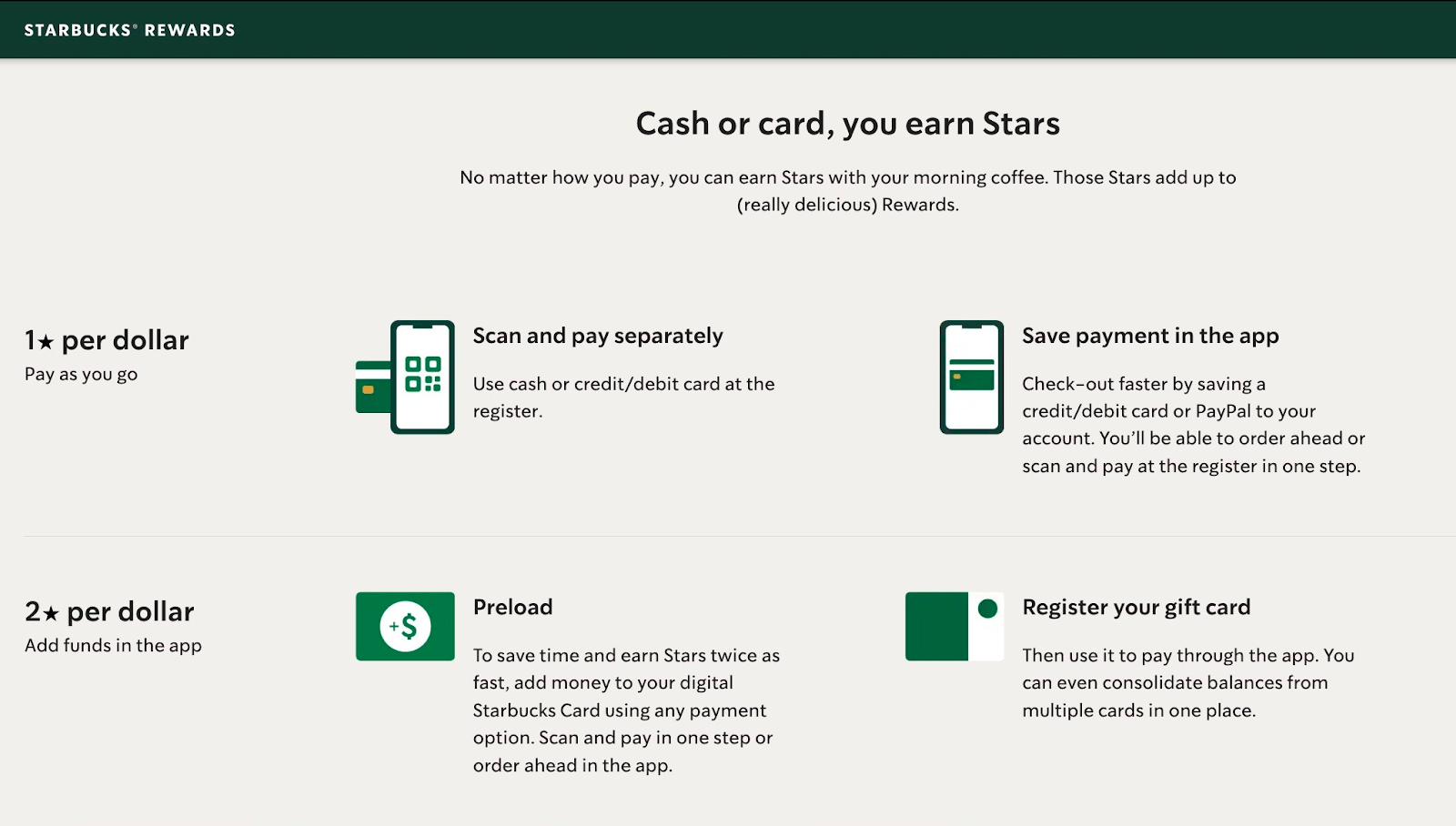
Starbucks Rewards allows its members to redeem their accumulated Stars at various levels, each unlocking distinct rewards. This structure caters to diverse preferences, allowing customers to either redeem their Stars for immediate benefits or save them for more substantial rewards.
- 25 Stars: Redeem for a free drink customization, such as extra flavor, espresso shot, or alternative milk.
- 50 Stars: Get a complimentary hot coffee, tea, or bakery item like a bagel or croissant.
- 150 Stars: Choose a free handcrafted drink, hot breakfast, or a parfait.
- 200 Stars: Earn a complimentary lunch item, like a salad, sandwich, or protein box.
- 400 Stars: Exchange for packaged coffee beans or select Starbucks merchandise.
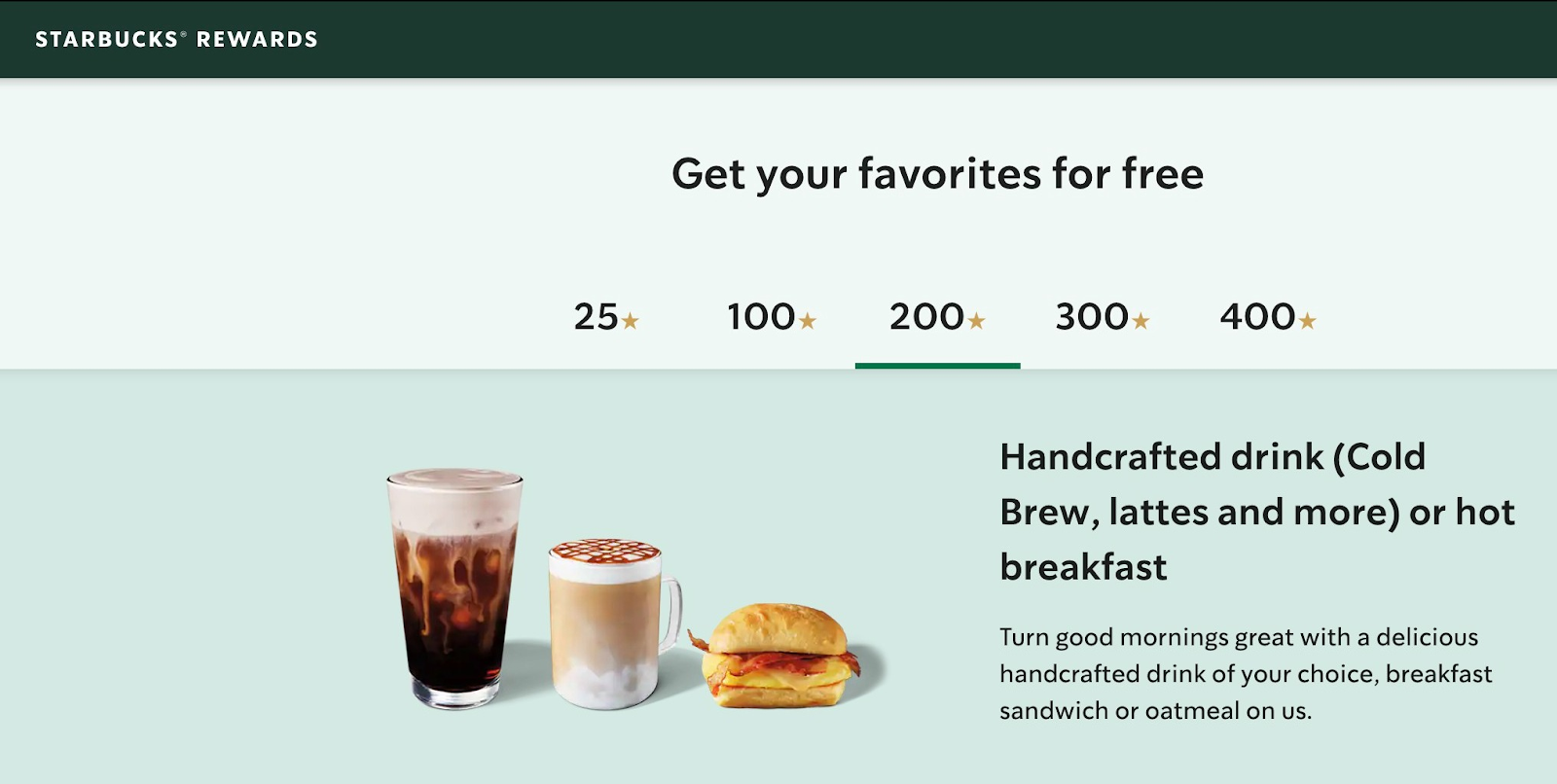
Coalition loyalty
Starbucks and Delta Airlines have embarked on a partnership, merging the world of coffee with the skies. Linking your Delta SkyMiles® and Starbucks® Rewards accounts opens up a new realm of earning opportunities and exclusive benefits.
- Travel-day perks: Double Stars on Delta travel days
- Everyday earn: 1 mile per $1* spent at Starbucks
- Exclusive offers: More opportunities to earn Stars and miles
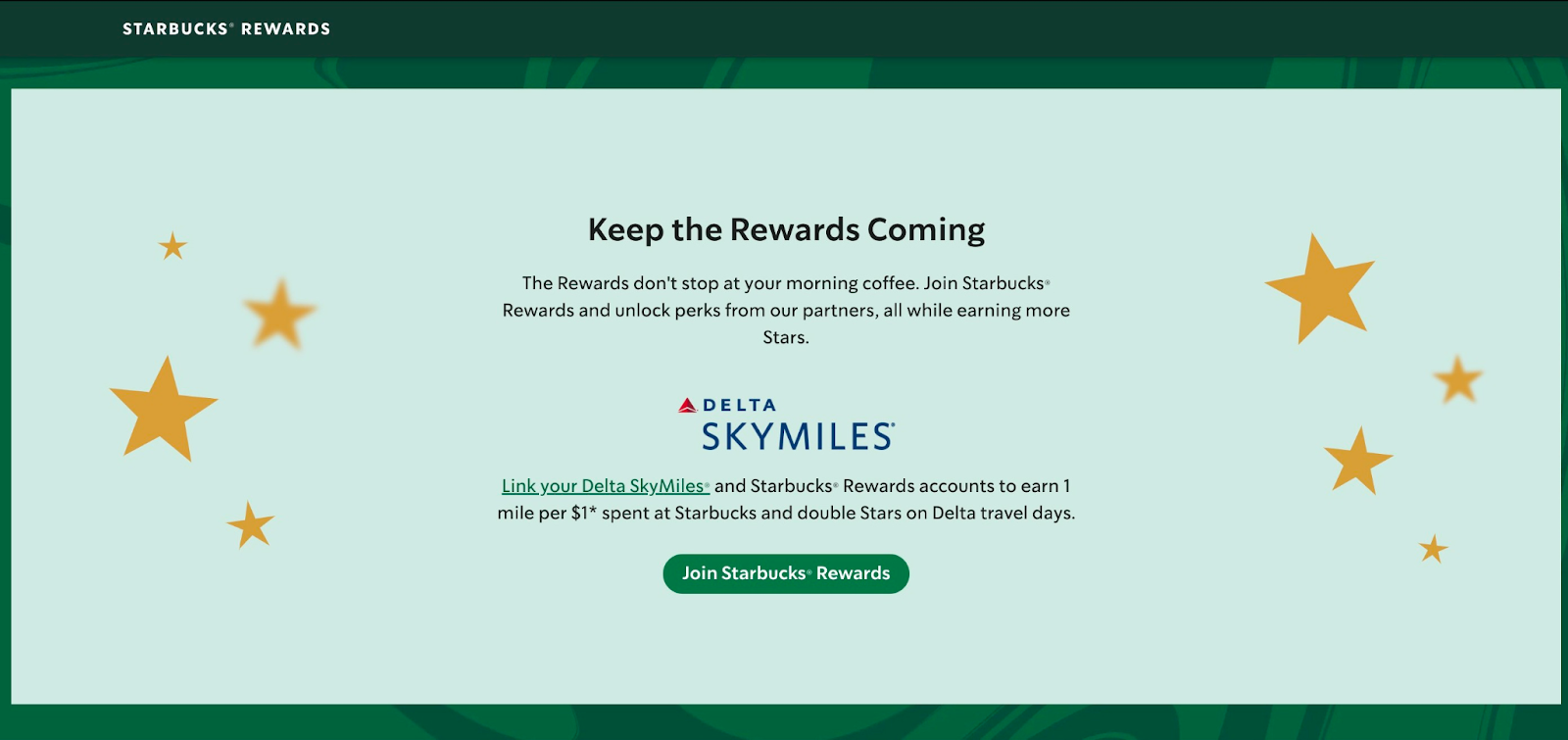
Interesting takeaways
Multi-channel communication.
Starbucks leverages multiple channels to communicate about its rewards program, ensuring widespread awareness and engagement. The use of a dedicated landing page, mobile app, points balance reminder emails , company blogs, and social media platforms creates an ecosystem where information about the program is readily accessible and consistently updated. The clarity and frequency of updates, including press releases for significant changes, demonstrate Starbucks’ commitment to transparency. This approach not only keeps existing members informed but also attracts new participants by clearly outlining the program’s benefits. Good communication is likely a significant factor in the program's high membership numbers.
Program simplicity and incentive structure
The simplicity of the points system (earn points and redeem for rewards) is user-friendly and easy for customers to grasp. This clarity enhances the appeal of the program and encourages participation. The structured nature of rewards incentivizes customers to accumulate more points to access greater rewards. This gamification element adds an extra layer of engagement, as customers are motivated to reach the next level. As customers get closer to a significant reward, their motivation to attain it increases. This psychological aspect of goal setting and achievement is a powerful tool in enhancing customer loyalty and encouraging more frequent purchases.
Incentivizing preloaded payments
Starbucks ingeniously incentivizes customers to preload their Starbucks account by offering double points for purchases made using a preloaded Starbucks Card. By preloading their accounts, customers commit themselves financially to future purchases at Starbucks, which effectively guarantees a degree of customer loyalty and repeat business. This strategy turns occasional visitors into regular customers, as the preloaded funds will likely be used exclusively at Starbucks locations. From a financial perspective, this strategy is beneficial for Starbucks. When customers preload their accounts, the brand receives cash in advance, improving its cash flow. This tactic also promotes increased engagement with the Starbucks mobile app, where preloading and tracking of rewards can be easily managed.
Coalition program with Delta Airlines
The partnership with Delta SkyMiles is a strategic move that broadens the program’s appeal. By collaborating with an airline, Starbucks extends its reach beyond the typical coffee shop customer. This alliance allows both companies to tap into each other’s customer bases, potentially attracting new customers who are loyal to one brand to become interested in the other. It’s a creative way to expand market reach without direct competition. For customers who already patronize both brands, this coalition loyalty program reinforces their loyalty and increases their engagement with both Starbucks and Delta. It creates a more integrated customer experience and can deepen the sense of brand loyalty.
Areas of improvement
The removal of the tiers system.
The previous iteration of the program had a 'Gold' tier, which was a smart way to acknowledge and reward the most loyal customers. By offering them the ability to earn points faster and providing exclusive benefits, Starbucks recognized and cherished its most valuable customers. This tier system not only incentivized increased spending but also gave a sense of exclusivity and status. While simplifying the program might make it more accessible for new customers, it risks diminishing the perceived value for power shoppers. The elimination of the tier system could lead to a decrease of engagement from these highly valuable customers.
Lack of personalized engagement or rewards
In the current market, personalization is key to customer engagement. Starbucks’ generic approach to rewards and communication, without considering individual customer preferences and behaviors, is a missed opportunity. Personalizing rewards and communications could significantly enhance customer loyalty and encourage repeat business. Leveraging customer data to offer personalized rewards and product recommendations could not only improve customer satisfaction but also drive product discovery and sales.
Limited post-purchase engagement
Post-purchase engagement is crucial in maintaining a connection with the customer even after they leave the store. This ongoing engagement is essential for converting first-time buyers into regular customers. While Starbucks has started initiatives like Starbucks Odyssey , which offers additional ways to earn rewards through digital journeys, its integration with the main rewards program appears to be lacking. A more seamless integration could enhance the overall experience and effectiveness of the loyalty program. Recognizing that some of these initiatives are in their early stages, there is potential for growth and improvement.
Learn from our library of loyalty program case studies
Similar Readings
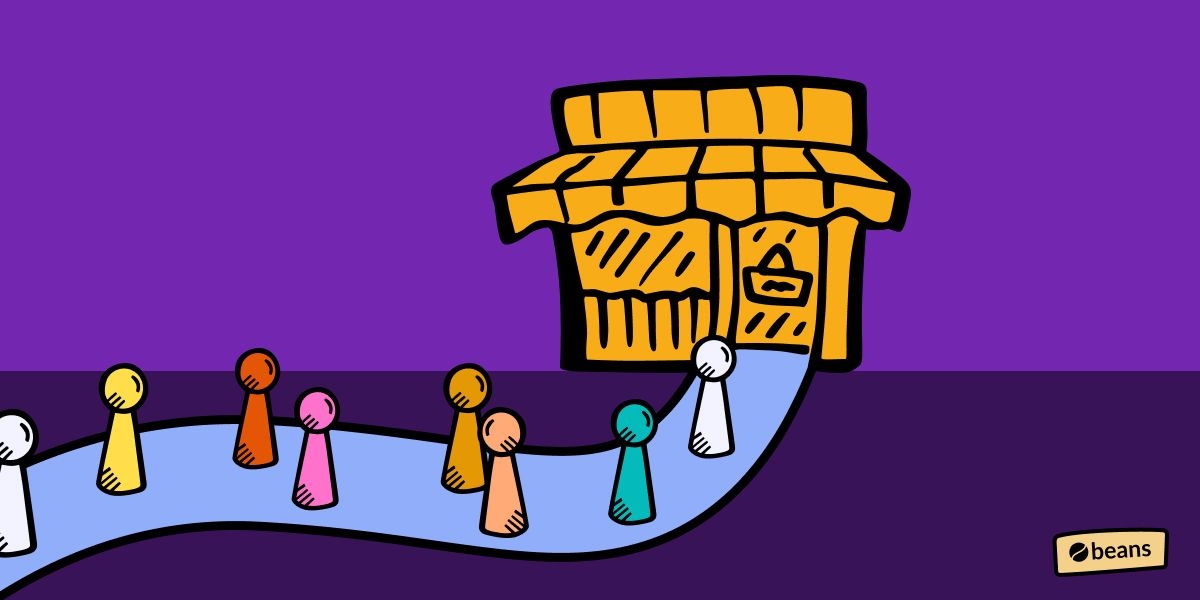
10 Ways to Increase Repeat Purchases on your Online Store
Repeat customers are the backbone of almost every successful business. Here are ten ways you can increase repeated purchases made in your store.
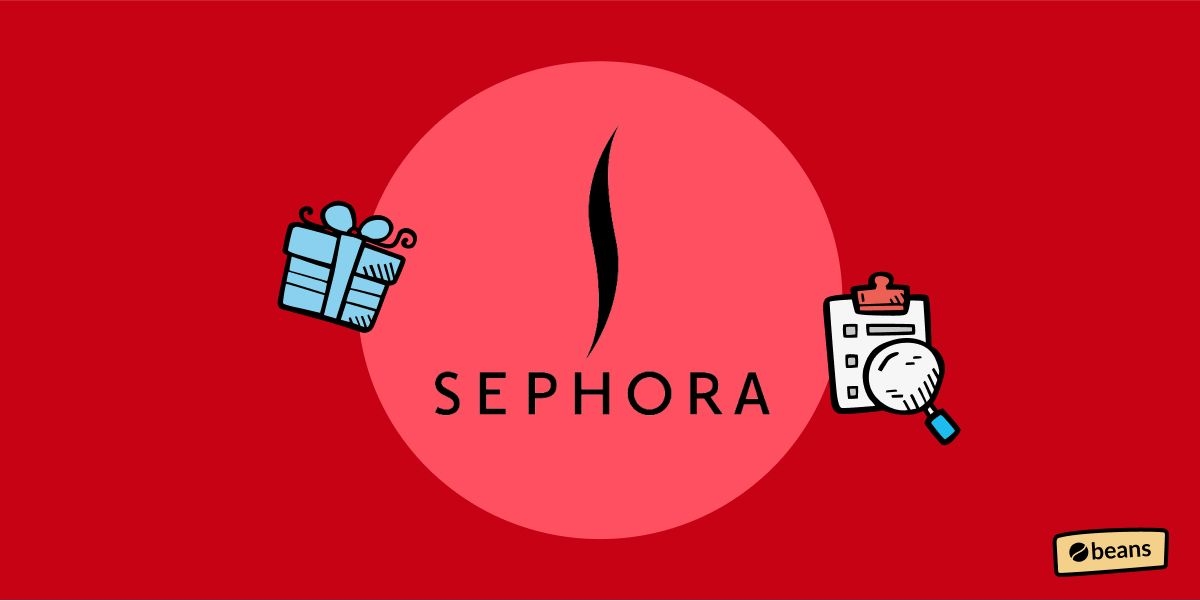
Sephora Beauty Insider Loyalty Program Review
While Sephora’s Beauty Insider has maintained its position of one of the most successful loyalty programs, it has gone through several phases to ensure that its customer base is glued to the benefits and experiences.
Ready to grow your business?
This site uses cookies to store information on your computer. Some are essential to make our site work; others help us improve the user experience. By using the site, you consent to the placement of these cookies.

Digital Innovation and Transformation
Mba student perspectives.
- Assignments
- Assignment: Digital Winners and Losers
Starbucks: Winning on rewards, loyalty, and data

Starbucks Rewards Program generates customer loyalty, increased revenue, and data for the company to create meaningful 1:1 relationships and personalized marketing efforts.
Starbucks Reward Loyalty Program
The Starbucks Reward Loyalty Program has a staggering 16 million active members (as of March 2019), with 11% growth of their user base in Q2 2018. Starbucks attributes 40% of its total sales to the Rewards Program and has seen same store sales rise by 7%. The Reward Program is available on mobile devices as the Starbucks app, and has seen impressive membership and growth since 2008, with multiple iterations on its original form. The investment made into the mobile interface has increased the frequency and spend of both regular and occasional customers. Starbucks uses this tool to individually market specific products and features based on data collected from the app about its users. Customers can order and pay through the app ahead of arriving at a physical location, as well as earn stars (rewards) that translate into free drinks, food, and merchandise. Starbucks is a clear winner that has reinvented their relationship with customers and captured enormous value through their investment into digital technologies.
How does Starbucks create value?
Customers benefit from using the app by:
- Ease of payment in store through mobile app
- Ability to order and pay ahead of arriving in store (and therefore skip any Monday morning rush lines by having a separate ‘mobile order pickup’ station – which in itself serves as a highly effective marketing tool for the app)
- Rewards and benefits: such as free refills on brewed coffee and free drinks on member’s birthdays, relatively quickly earned other rewards from purchases, such as free food/drinks/merchandise
- Special member events
- Ability to send other members and friends gift cards through the app
- App integration with other platforms such as Spotify to discovery music playing in store (a big part of Starbucks and more generally coffeehouse culture)
- Members are first to know about upcoming seasonal and new product releases
Starbucks reaps many of its own ‘rewards’ from the app:
Pathways to a Just Digital Future
All these features have created an intense loyalty for customers to the app and reward program, which kicks back nicely for Starbucks. Members of their rewards program are feeding in valuable data that Starbucks can then mine to personalize marketing efforts to individuals and create a uniquely direct relationship with their customers. Besides drawing in the ‘occasional user’ to come back and increase their frequency of purchase (key in this business), the app has also been seen to increase the frequency and spend of regular and super-user customers. According to CFO Patrick Grismer, “We know from our experience that when customers join our rewards program, their total spend with Starbucks increases meaningfully”.
Aside from the increase in revenue associated with the app, the real value lies in the innovative potential uses for the large amounts of user data collected, which forms the base of Starbucks’ digital strategy. Starbucks has begun experimenting with digital menu boards in their physical locations to allow for a dynamic menu based on customer demand (varying with regional preferences and times of day), that would ideally continue to boost same store sales. The decision of where to place new stores and how to expand has also been informed by this user data. The ways in which this user data can be used in the future are important in the ever more personalized retail world, where customers want less of being ‘talked at’ and more of being included in a conversation.
What’s Next?
Starbucks continue to prove itself to be truly customer centric, building innovation around the core theme of their relationship with customers. Their willingness to adapt and invest in their digital technology has allowed them to create and capture enormous value for both customers and the company. As Starbucks gets access to more customer data, the ability to continue to create more meaningful, personal relationships with customers will only increase, and this is how Starbucks is positioned to win in the future. They have continued to innovate on ease of use with the app, now integrating voice as a feature when ordering for mobile pickup. Of course, Starbucks will have to continue within this theme of digital innovation to remain a winner in the future. Use of consumer data builds a strong base for a number of potential technologies to harness in the future, but it doesn’t guarantee success.
https://www.e-zigurat.com/innovation-school/blog/companies-digital-transformation-strategies/
https://www.restaurantbusinessonline.com/marketing/starbucks-rewards-program-pushes-chains-growth
https://www.usatoday.com/story/money/2019/03/19/starbucks-redesigns-its-loyalty-program-so-you-get-free-stuff-sooner/3174227002/
https://zinrelo.com/loyalty-rewards-case-study-new-starbucks-rewards-program.html
https://themanifest.com/app-development/success-starbucks-app-case-study
Student comments on Starbucks: Winning on rewards, loyalty, and data
I loved this post, Leah! (Not just because I’m a Starbucks junkie and heavy user of the app.)
One thing that I think about whenever I use mobile ordering is the way my experience has changed in the store – I spend less time on the transaction, keep my headphones in, and don’t have to interact with anyone behind the counter. This is a huge positive for me (e.g., when I’m in a rush) and probably makes me lower cost-to-serve for Starbucks, but I wonder does the presence of in-and-out customers like me make non-mobile users’ experience worse? Are they served more slowly? Do they no longer enjoy lingering over a book in Sbux’s “third place” when there’s a constant stream of mobile customers with headphones in, coming and going? Maybe this is why Starbucks is doubling down on its Reserve Roastery high-end concept, to segment out the grab-and-go types like me from the coffee shop experience-seekers.
To generalize, it seems that greater investment in/growth of digital channels can negatively impact traditional channels if not addressed proactively.
Really good point!
Great article highlighting Starbucks, Leah!
Your blog post reminds me of our first case in class on Dominos Pizza. At one point, Dominos was considered a huge winner in the app/delivery space as they were an early adopter of app & ordering technology. But as competition moved quickly, other players such as UberEats and DoorDash threaten the competitive advantage these single-brand apps, such as Dominos, had developed. I sat in class wondering if Dominos could follow the Starbuck’s app model and develop a loyalty program, or if selling pizza vs. cappuccinos are just too different of business models?
Interesting read! I think the membership programs that have become increasingly common in retail are an interesting way for traditionally analog companies to begin to experiment in the digital world. There is clearly value on the table for both the company and the consumer so I can imagine it would be an easier internal sell than some other digital transformation projects. I wonder how Starbucks will continue to improve their application to build an experience that connections the physical and digital worlds for their consumers and differentiate against other big chain coffee shops.
Thanks Leah for the interesting post. I completely agree that the reward loyalty program is an effective initiative to reduce the customer churn due to the entry of new coffee players. However, I believe that it is even more important to improve the customer experience by creating new products that match with the evolving preferences of customers. As you mentioned in the article, data will play a critical role in the future to offer a more personalized service. Starbucks has developed some initiatives in this line. For example, in 2019 Starbucks installed 1,900 Mastrena II expresso makers, which have IoT sensors for preventive maintenance purposes. This initiative will allow Starbucks to reduce machines’ failures, reduce customer wait time and improve customer experience. In the future, Starbucks should continue working with data to improve their products and increase customer retention.
Great analysis Leah and really unique viewpoint on what’s next for Starbucks! As brands continue to focus on building a deeper connection with their consumers loyalty programs that collect more personalized data and usage trends will help organizations better differentiate their service and product offerings. I am curious as Starbucks begins to really leverage big data what major changes do they decide to implement. There may be opportunities to decentralize operations and curate offerings providing localized products, location designs, and services which can further help Starbucks capture a larger share of wallet.
Great post, Leah!
I feel conflicted about Starbucks’ shift to the digital channel that allows for a greater number of customers to be served in a shorter amount of time. Personally, I’m the type of customer that spends hours at coffee shops for the quiet and relaxing ambiance, smell of coffee, and calming music. These days, Starbucks stores feel more like McDonald’s and the relaxing user experience has been completely lost. While they’ve now lost me as a customer, I recognize that they’ve gained 8 in my place that probably result in higher profitability. A win for Starbucks, but unfortunately a loss for me.
Great post! This is super interesting to me – I had no idea this was such a powerful tool. There is one main thing I’m wondering about: What do you think allowed Starbucks to be more successful than other coffee shops with their Rewards program? Was it more the technology, the convenience, the recommendations, or the combination of everything together? I guess my thought is that I don’t know why more companies haven’t been able to replicate this.
A second thought is just that the power of this loyalty seems so strong that it may be impossible to disrupt, despite lower prices elsewhere. We see new coffee shops popping up all the time, and I’m not sure any of them stand a chance knowing this.
Thank you for sharing! This has opened my eyes to how important loyalty is and how brands can work on building that with customers.
Leave a comment Cancel reply
You must be logged in to post a comment.
More From Forbes
Starbucks just set two digital transformation marks that cannot be ignored.
- Share to Facebook
- Share to Twitter
- Share to Linkedin
Gartner forecasts 2022 global IT spending will rise 5.5% to over $4.5 trillion. However, the supply chain crisis and continued inflation fuel liquidity risk that can quickly reduce, postpone or derail tech budgets.
Accordingly, accounting and advisory firm Kreston Reeves recently warned , “The physical impact of stressed supply chains is hitting many businesses hard and is likely to do so well into 2022. A cash flow crisis is likely to follow in the next six to 12 months as margins are squeezed leaving businesses with shortfalls in working capital.”
In response, c-suites must quickly and creatively devise novel solutions that drive revenue growth, stave cost-cutting pressures and preserve cash.
That’s nothing new for Starbucks. The coffee giant’s Q4 FY2021 results exemplify how executing a customer-loyalty digital strategy can deliver ample cash flow for immediate spending needs, future capital expenditures and record dividends.
New heights
Starbucks prioritizes customer loyalty metrics to gauge success and forecast future performance. Quite impressively, on its FY 2021 Q4 earnings call, Starbucks reported that nearly 25 million of its customers visit at least once per quarter and now account for over half of all U.S. store transactions.
In addition to exceptional customer service, Starbucks CEO Kevin Johnson attributes much of the success to tech investment, highlighting, “We continue to build and leverage our technology first mobile and digital capabilities and accelerate growth in active Starbucks Rewards membership. We grew our 90-day active Starbucks Rewards members representing our most loyal and engaged customers by approximately 30% in FY2021 to 24.8 million members.”
Best Travel Insurance Companies
Best covid-19 travel insurance plans.
“Noteworthy is that in Q4, 51% of U.S. tender for company-operated stores was generated by this loyal customer base. We continue to nurture and deepen our direct personalized digital relationship with members with enhancements to [our] Stars for Everyone program,” he emphasized.
Secondly, Starbucks expects record customer stored value card prepayments. Johnson forecasted, “We are also anticipating that nearly $3 billion will be loaded on Starbucks cards this [holiday] season by leveraging our digital and out-of-store distribution channels and creating a promotional presence in drive-through lanes where we have seen significant channel shift during the pandemic.”
That prepaid sum is up over 50% from 2019 levels and itself nearly covers Starbucks combined FY2021 and FY2022 capital expenditures. Starbucks CFO Rachel Ruggeri detailed, “Capital expenditures in fiscal 2022 are expected to total approximately $2 billion, up from $1.5 billion in fiscal 2021 and back to pre-COVID levels, reflecting increases in new store development and technology initiatives in our stores.”
It’s rare for CFOs to find such quick payback and cash flow flexibility.
What’s brewing
Spearheaded by CTO Gerri Martin-Flickinger, Starbucks aims to leverage and bolster its strong brand with additional investments in predictive analytics and automation.
On the FY 2021 Q2 earnings call, Johnson reinforced, “We also see a clear opportunity to further modernize and reinforce our leadership position, leveraging our strength in technology and predictive analytics, as well as the continued transformation of our store portfolio, offering experiences that will drive greater customer loyalty.”
As Starbucks scales past $30 billion in annual revenue, Brady Brewer, Starbucks chief marketing officer, points to digital loyalty for growth. He explained, “Stars for Everyone makes it easier to join and purchase, including a pay-as-you-go option. [By] lowering those barriers to entry, reaching [new] people and then ensuring that the incentives and the services make the experience personalized and effortless — that's how we're growing the program. We've seen just tremendous results with attracting [and activating] new members.”
Johnson added that machine-learning algorithms aid his goal of doubling the frequent customer base to nearly 50 million members. “I'm not going to give a time frame. It might take a couple years, but double that [member] number. And in doing that, we've now started to apply some very creative and very thoughtful ways to [analyze customer] data so that even if they're non-rewards customers, we can better serve them and start to personalize offers and the experience.”
To meet in-store customer service needs, Starbucks increasingly relies on automation for employee scheduling, inventory management and equipment diagnostics. Johnson emphasized “We've driven automated ordering for food and merchandise, it will be fully rolled out across all of our U.S. company-owned stores and then in addition, we continue to make investments in equipment - whether it's the [coffee] strainer, warming ovens or our cold brew system.”
Clearly, Starbucks tech investments’ primary focus is driving customer loyalty — that’s a high-ROI common starting point that all companies can embrace.
Loyalty rewards
Starbucks’ results are impossible to ignore. More frequent customer buying and record advances are two hallmarks that deliver cash flow cushions to well-run businesses — in any economy. Those customer loyalty metrics certainly offer a worthwhile topic for the next workplace coffee conversation too. Who’s in?

- Editorial Standards
- Forbes Accolades
To read this content please select one of the options below:
Please note you do not have access to teaching notes, starbucks’s loyalty reigns.
Publication date: 9 February 2016
Teaching notes
By July 2015, 20% of Starbucks’s payments in the United States came through its mobile app. The company had created a tool to both drive loyalty and grow its customer base. No stranger to innovation, Starbucks was partnering with iTunes as early as 2007, earned its first mobile marketer of the year award by 2010, introduced its mobile app in 2011, and by 2015, 94% of Facebook users were either fans of Starbucks or friends with someone who was. This case explores the company’s commitment to mobile and its social media prowess, and considers just what it takes to drive loyalty in a customer base.
Murray, M. (2016), "Starbucks’s Loyalty Reigns", . https://doi.org/10.1108/case.darden.2021.000023
University of Virginia Darden School Foundation
Copyright © 2016 by the University of Virginia Darden School Foundation, Charlottesville, VA. All rights reserved.
You do not currently have access to these teaching notes. Teaching notes are available for teaching faculty at subscribing institutions. Teaching notes accompany case studies with suggested learning objectives, classroom methods and potential assignment questions. They support dynamic classroom discussion to help develop student's analytical skills.
Related articles
All feedback is valuable.
Please share your general feedback
Report an issue or find answers to frequently asked questions
Contact Customer Support
Decoding The Starbucks Marketing Strategy: A Complete Guide
By Aditya Shastri
Quick Read Discover how Starbucks has perfected its marketing strategy to dominate the coffee industry. This Starbucks case study delves into its innovative marketing techniques, digital strategy, and recent campaigns, showcasing why it remains a market leader.
Learn From Asia’s #1 Digital Marketing Institute
AI-Based Curriculum
Dive in to the future with the latest AI tools
Placement at top brands and agencies
Talk to counsellor
About Starbucks
Established in 1971 in Seattle, Washington, Starbucks began as a lone storefront specializing in premium coffee beans and equipment. It has grown into a global coffeehouse chain with over 30,000 locations worldwide. The company’s mission is to uplift and nourish the human spirit—one individual, one cup of coffee, and one community at a time. Known for its commitment to sustainability and ethical sourcing, Starbucks is a pioneer in creating a unique coffee culture.
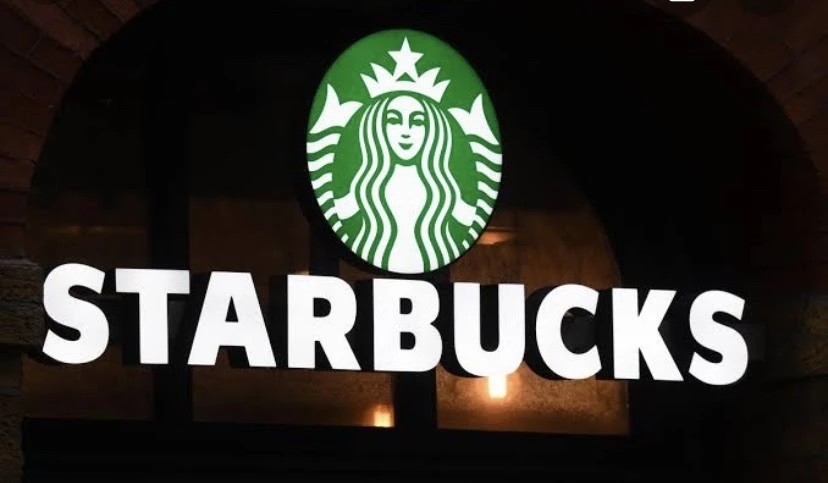
Source: Google
Relevant Updated Statistics
- As of 2023, Starbucks operates in over 80 countries with 33,833 stores globally【source: Statista】
- Starbucks’ revenue for 2022 reached $29.06 billion, a 24% increase from the previous year【source: Starbucks Annual Report 2022】
- The brand’s loyalty program, Starbucks Rewards, has over 24.8 million active members in the United States【source: Starbucks Investor Relations】.
What’s New With Starbucks
Business news.
Starbucks announced plans to open 1,000 new stores in China by 2025, strengthening its presence in one of its fastest-growing markets.
Product Launch
In 2023, Starbucks introduced the Oleato range, featuring coffee infused with olive oil, a bold new addition to their beverage lineup.
Marketing News
Have you ever been called the wrong name? It might seem like a minor detail, but for transgender and non-binary individuals, it can be a daily experience. Starbucks recognized this in their powerful campaign, “Every Name’s a Story.” This campaign wasn’t just about selling coffee – it was about celebrating inclusivity and diversity.
Celebrity News
In collaboration with singer Taylor Swift, Starbucks promoted the ‘Red (Taylor’s Version)’ album by featuring her favourite drink, the Caramel Nonfat Latte, in stores worldwide.
Are you ready to unlock your full potential in the thrilling world of digital marketing? Our PG program is just what you need. Enrol in our Post-Graduation in Digital Marketing and explore the opportunities now.
But for now, let us continue with our case study on the marketing strategy of Starbucks.
Starbucks Target Market
Starbucks, a premium coffee brand, strategically positions itself in the market with a keen focus on high-income spenders and health-conscious professionals. The market positioning of Starbucks is evident in its appeal to urban, on-the-go consumers seeking quality coffee and a tranquil environment to unwind.
This market positioning of Starbucks attracts a diverse clientele, including technology early adopters and those flexible to change, primarily aged 25-45. Starbucks’ success is built on a deep understanding of its target audience.
This allows them to constantly adapt their offerings and marketing strategies to meet evolving consumer trends and preferences. This case study will explore how Starbucks uses this knowledge to stay ahead of the curve.
This approach underscores Starbucks’ commitment to reaching beyond the storefront, offering not just coffee but an experience tailored to its discerning clientele.So summed up, their target audience is-
- High-income spenders
- Technology early adopters
- Health-conscious professionals
- Flexible to change
- Reaching beyond the storefront (Online Sales & Engagement)
Also Read: Digital Marketing Courses in Mumbai
🚨 FREE MASTERCLASS
Building a Profitable Instagram Strategy
Worked with:
Register For Free
IG Content Creater With 10+ million views
Buyer Persona
To provide a clearer understanding of Starbucks’ target audience, refer to the Buyer Persona outlined in our Starbucks case study blog.

Buyer’s Persona
Profession:
Web-Developer
- Seeking a premium coffee experience
- Interested in sustainable and ethically sourced products
- Value convenience and loyalty rewards
Interest & Hobbies
- Enjoying quality time at coffee shops
- Passionate about environmental causes
- Engaged in social media and digital trends
Pain Points
- High prices compared to local coffee shops
- Limited seating in busy locations
- Preference for non-dairy or alternative milk options
Social Media Presence
Starbucks in india.
In the 2010s, Starbucks’ marketing strategy focused on entering the Indian market to capitalize on the ever-growing coffee culture, particularly targeting the niche upper-class segment. Despite an initial announcement in 2007, Starbucks withdrew its plans without explanation, finally making a grand entry in 2011. To establish a strong foothold, the world’s biggest bistro chain forged a 50-50 joint venture with Asia’s largest coffee grower, Tata Consumer Products Limited, for their Starbucks coffee marketing strategy.
Successfully launching its brand, Starbucks’ next critical move was to meticulously define and engage its target audience in India, ensuring sustainable growth and market presence. This strategic approach, outlined in this Starbucks case study, highlights its methodical entry into the Indian market and the partnership that facilitated its successful establishment in the region.
Now, without further ado, let’s get straight into Starbucks’s marketing tactics, exploring their strategic approaches and methods in the market.
Marketing Strategies of Starbucks
Initially, Starbucks’s marketing tactics in India focused on segmenting consumer markets on a socio-economic basis, targeting working professionals seeking a soothing workspace. They strategically placed stores in locations where this demographic was prevalent.
Like many companies entering new markets, Starbucks started with a single segment and expanded upon achieving initial success. Over time, they diversified their target audience to include teenagers and young adults, bolstering their Starbucks coffee marketing strategy through product range expansion and enhanced social media presence.
The market positioning of Starbucks hinges on delivering a unique, differentiated experience that solidifies its reputation as a highly esteemed brand. Their marketing mix integrates digital technology and social media extensively, engaging the modern, tech-savvy generation for promotions and customer interaction.
This approach has not only fortified their brand identity but also fostered a deep connection with their diverse customer base.
Note: To enhance your expertise, you can explore various courses on digital marketing online that provide in-depth knowledge and the latest industry trends.
Digital Expansion
One of the key priorities of Starbucks’s marketing strategy is expanding its digital interactions with customers. To achieve this goal, it implements several strategies to attract digitally registered customers beyond the rewards program. For example, the coffee chain is offering mobile order services and leveraging Wi-Fi sign-ins at its physical stores.
Starbucks Social Media Strategy
Most people are familiar with Starbucks on social media. The company features several social media accounts that are known for their distinctive branding, interactive posts, and visually pleasing content. The diverse range of content includes recipes, photography, articles, and features. But there’s more than meets the eye. The stream of content can be broken down into a series of campaigns geared at creating a greater sense of Starbucks marketing techniques, enhancing brand awareness, and fostering a sense of community.
Starbucks Product-based Marketing Campaigns
The company focuses on promoting unique and fan-favourite beverages as part of its Starbucks coffee marketing strategy. The brand understands the popularity of its flagship items, particularly the Pumpkin Spiced Latte and Frappuccino, and recognises the demand for this type of content among its audience.
They have even established dedicated social media accounts for these customer favourites, where they actively share relevant and relatable memes to engage their loyal fan base. Additionally, Starbucks leverages user-generated content (UGC), often featuring consumer images of visually appealing products like the Unicorn Frappuccino.

These images are not only reshared across official channels but also incorporated into influencer campaigns, further amplifying their digital marketing efforts.
Starbucks Corporate Social Responsibility-based campaign
Starbucks’ marketing tactics involve leveraging social change as a tool, positioning itself as open-minded and inclusive. One notable example is the #ExtraShotOfPride campaign, which actively supports the LGBT+ community.
Community-based campaigns

#RedCupArt campaign
Another facet of Starbucks’s marketing strategy is its emphasis on highlighting individuals and communities. Take a look at the #RedCupArt campaign, which not only increases engagement but also provides them with a library of UGC content. They use storytelling to showcase acts of courage and kindness in American communities, localizing the content.
Starbucks’s marketing techniques consciously humanize the company by sharing stories on their account, spotlighting employees who play an essential role, especially when consumers are distrustful of big brands.
Just like Starbucks coffeehouses fostered a sense of community in person, their online coffee content creates a similar social experience. This reflects their pioneering role in shaping modern coffee culture.
Festive Marketing
Starbucks has also initiated a new seasonal whole-bean coffee, #StarbucksDiwaliBlend, for its consumers across the country and select global markets. The latest exquisite blend is hand-picked and sourced from Tata Estates in Karnataka and Tamil Nadu.
The Starbucks Diwali Blend was intended as a tribute to the region’s rich and cultural coffee heritage and expertise. They launched the #SketchTheBlend campaign where customers have to share their creativity on the Diwali Blend cup and sleeve and could win 5 free beverages.
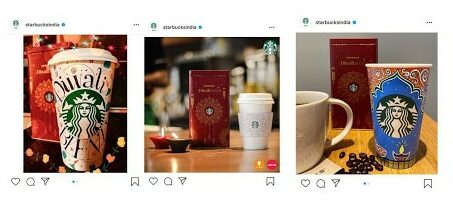
Now that you understand the various strategies that comprehensively contribute to their top-notch Starbucks coffee marketing strategy. Let’s dive deeper and analyse their overall digital presence.
Digital Marketing Strategies
Seo (search engine optimization) strategy:.
Starbucks’s marketing tactics involve optimising its online presence by incorporating relevant keywords, high-quality content, and a user-friendly website to improve search engine rankings.
Social Media Marketing Strategy:
Starbuck’s marketing strategy includes actively engaging with customers on social media platforms, by running targeted ads and interactive content to boost engagement. The brand actively engages with customers on social media platforms, running targeted ads and interactive content to boost engagement.
E-commerce Strategy:
Starbucks’ online store offers a seamless shopping experience, from purchasing coffee beans and equipment to ordering ready-to-drink products.
Mobile App:
The Starbucks mobile app enhances customer convenience with features like mobile ordering, payment, and rewards tracking, showcasing a key aspect of Starbucks’s coffee marketing strategy.
Influencer Marketing Strategy:
Collaborating with influencers and celebrities, Starbucks effectively reaches a broader audience and creates buzz around new product launches and campaigns.
Bonus: Enrolling in a digital marketing course can provide you with the essential skills and knowledge to understand and implement successful strategies, much like those employed by Starbucks.
Starbucks knows its audience is technologically advanced, which makes it imperative for them to have a strong digital marketing strategy. It’s clear how Starbucks prefers marketing on platforms where they have two-way communication instead of platforms like print and television which is more of a one-way communication.
Marketing and Advertising Campaigns
One of Starbucks’ most famous campaigns is “Meet Me at Starbucks,” a global initiative that highlights the diverse ways people connect at their stores. The campaign emphasized the brand’s mission to foster human connection and resulted in increased customer engagement and brand loyalty.

Starbucks launched its social media campaign in 2 phases. The first phase was where they asked their customers to share their ways of reconnecting amidst the pandemic and share their favourite Starbucks memories on their personal Instagram handles with the hashtag Starbucks advertising strategy. In the second phase- ‘Half Cup Full’- they asked their customers to comment on their favourite beverage on the post. They then sent these customers voice notes of baristas hollering the customers’ names along with their favourite beverage to remind them of the famous in-store experience.
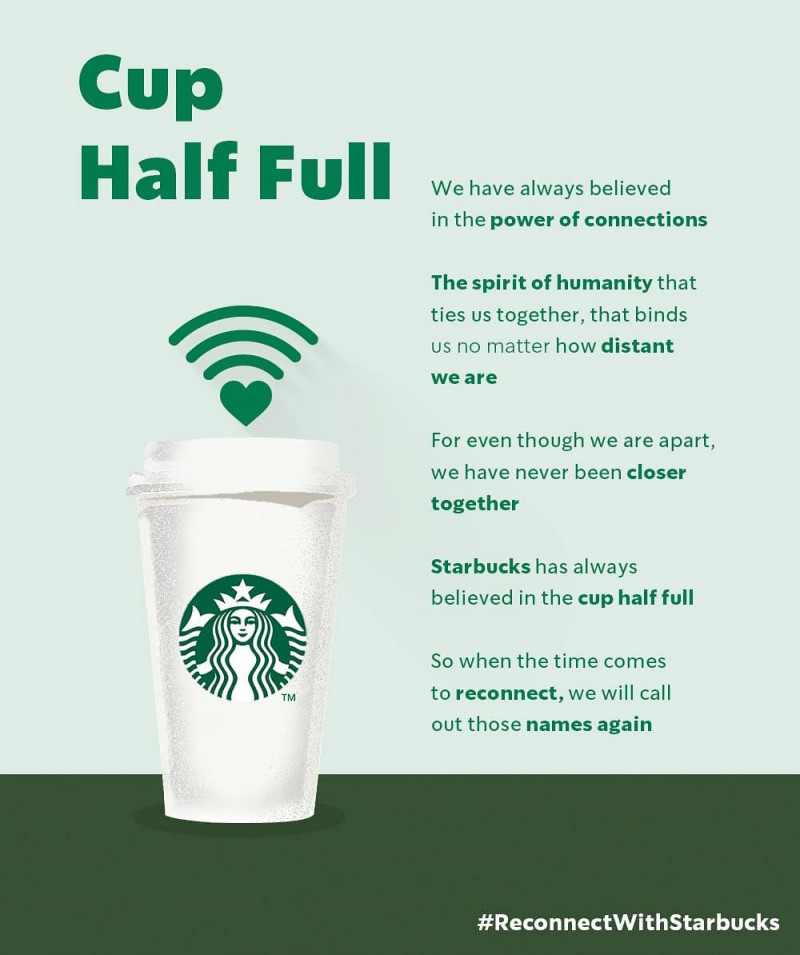
This was a great campaign as it not only reminded the people of all the good memories with Starbucks but also made them feel important and valued.
Campaign Analysis:
Starbucks employs a variety of marketing techniques to maintain its market positioning. These include personalised marketing through their rewards program, located store experiences, and a focus on sustainability. Their recent ‘Every Name’s a Story’ campaign is an excellent example of leveraging social issues to build brand loyalty.
Read more about: For skill enhancement, explore our digital marketing courses in ahmedabad and digital marketing courses in south delhi , created to suit your requirements.
Failed Campaigns
#racetogether campaign.
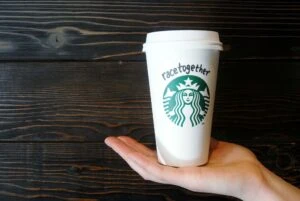
The campaign aimed to spark conversations about race by having baristas write “Race Together” on cups, which was met with widespread criticism.
Customers and employees felt uncomfortable and questioned the appropriateness of discussing such a sensitive topic in a coffee shop setting.
Starbucks quickly scaled back the campaign, focusing instead on internal initiatives to promote diversity and inclusion.
Top Competitors
In this Starbucks case study, we will explore its competitors and how Starbucks consistently rises above them, showcasing its resilient Starbucks marketing strategy.
Dunkin’ Donuts
Renowned for its extensive range of coffee blends and delectable baked goods, Dunkin’ Donuts has established itself as a favourite among coffee enthusiasts and snack lovers alike.
McDonald’s coffeehouse brand offers a budget-friendly assortment of coffee beverages, providing customers with a convenient and affordable coffee experience alongside their meals.
Costa Coffee
A prominent British coffeehouse chain, Costa Coffee is celebrated for its European presence and commitment to delivering quality coffee in a cosy café atmosphere.
Peet’s Coffee
Known for its artisanal approach to coffee roasting, Peet’s Coffee specialises in high-quality, hand-roasted beans that cater to discerning coffee connoisseurs seeking exceptional flavour profiles.
Tim Hortons
A beloved Canadian institution, Tim Hortons is cherished for its signature coffee blends and freshly baked doughnuts, offering a comforting taste of Canadian hospitality to customers nationwide.
Be it Starbucks or any other company, competition is everywhere. So if you are someone who likes doing research on competitor analysis for other companies, let me help you out. Check out these case studies on the marketing strategy of Jollibee , McDonald’s marketing strategy and the marketing strategy of Dunkin Donuts .
In conclusion, Starbucks’ marketing strategy is a testament to its success in the coffee industry. By focusing on high-income spenders, urban professionals, and tech-savvy individuals, Starbucks has effectively positioned itself as a premium brand.
Their innovative campaigns, such as ‘Every Name’s a Story’ and ‘Meet Me at Starbucks,’ highlight their commitment to inclusivity and human connection. The integration of digital strategies, social media engagement, and a robust rewards program further strengthens their market presence.
By continuously adapting to consumer trends and leveraging strategic partnerships, Starbucks remains a leader in the global coffee market.
Additional Information
Want to learn the essentials of digital marketing in no time? Our extensive Online Digital Marketing Course will help you unlock success in this evolving industry.If you have reservations about enrolling, try our Free Digital Marketing Masterclass first! Get a preview of the content and decide if it’s a good match for you.
Alternatively, if you’re interested in the world of social media, our Free Instagram Marketing Course might be the perfect fit.
Lastly, if you enjoyed this blog, we recommend exploring our digital marketing case studies. We’ve covered some of the best companies out there. A few the examples are marketing strategy of Amazon , the marketing strategy of Red Bull and the marketing strategy of LinkedIn .
Don’t forget to check out our digital marketing blogs as well. You might find your perfect course among them!
We appreciate you reading this blog. Comment down below if you want more such case studies.
Frequently Asked Questions- Marketing Strategy Of Starbucks
Starbucks' mission is to inspire and nurture the human spirit – one person, one cup, and one neighbourhood at a time.
Starbucks operates over 32,000 stores worldwide, making it one of the largest coffeehouse chains globally, known for its extensive global presence and accessibility.
Starbucks' latest product launch includes a range of summer-inspired beverages like the Iced Guava Passionfruit Drink and the Nitro Cold Brew with Salted Honey Cold Foam.
Starbucks' main competitors include Dunkin' Donuts, McCafé (McDonald's coffeehouse brand), Costa Coffee, Peet's Coffee, and Tim Hortons, each vying for market share in the coffee and quick-service restaurant industries.
The Starbucks Rewards program is a loyalty program where customers earn points (stars) for purchases, which can be redeemed for free drinks and food items, along with personalised offers and early access to new products.
Through initiatives like ethically sourced coffee, reducing waste, and promoting recycling.
The 'Race Together' campaign was an initiative by Starbucks aimed at sparking conversations about race relations. It encouraged employees to write ‘Race Together’ on cups to prompt dialogue among customers and staff.
Starbucks' digital marketing strategy leverages social media platforms and mobile apps to engage customers with personalised offers, loyalty programs, and interactive content, enhancing brand visibility and customer experience.
Starbucks' target audience is motivated by quality coffee, a cosy ambience, and a sense of community fostered by the brand's commitment to social responsibility and customer-centric experiences.
Starbucks leverages social media to engage customers through creative campaigns, customer interactions, and promotions, enhancing brand visibility and fostering a sense of community among coffee enthusiasts worldwide.
Author's Note: My name is Aditya Shastri and I have written this case study with the help of my students from IIDE's online digital marketing courses in India . Practical assignments, case studies & simulations helped the students from this course present this analysis. Building on this practical approach, we are now introducing a new dimension for our online digital marketing course learners - the Campus Immersion Experience. If you found this case study helpful, please feel free to leave a comment below.
" * " indicates required fields
IIDE Course Recommendation

Get Syllabus
By providing your contact details, you agree to our Terms of Use & Privacy Policy
Aditya Shastri
Lead Trainer & Head of Learning & Development at IIDE
Leads the Learning & Development segment at IIDE. He is a Content Marketing Expert and has trained 6000+ students and working professionals on various topics of Digital Marketing. He has been a guest speaker at prominent colleges in India including IIMs...... [Read full bio]
Clicking on the image of the Starbucks cup is my thing too. This blog provides great and deep insights into their strategy.
Starbucks marketing strategy brewed! served! and I’m here for it!
Submit a Comment Cancel reply
Your email address will not be published. Required fields are marked *
Submit Comment
This site uses Akismet to reduce spam. Learn how your comment data is processed .
Related Posts
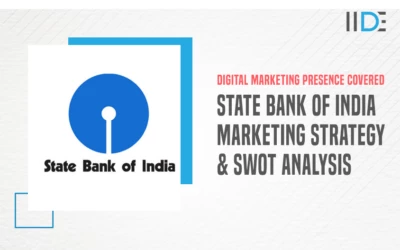
Extensive SWOT Analysis of SBI: Indian Multinational Bank
by Aditya Shastri | Sep 25, 2024
Quick Read The blog on a detailed SWOT analysis of State Bank of India (SBI), highlighting...
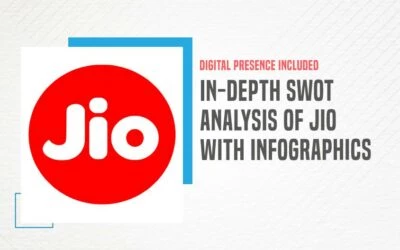
In-Depth SWOT Analysis of Jio – Market Leader of Telecommunication Industry
by Aditya Shastri | Sep 10, 2024
Quick Read The SWOT analysis of Jio highlights the company’s strengths, including...

In-Depth Case Study on Marketing Strategy of Dabur
by Aditya Shastri | Sep 6, 2024
Quick Read The marketing strategy of Dabur focuses on leveraging its ayurvedic heritage,...
I’m Interested in This Masterclass
The Success of Starbucks App: A Case Study
Starbucks has the most regularly used loyalty rewards app among major restaurant chains. But what keeps users coming back for more? This case study will look at the design of the app, its features, and the bold moves that the coffee chain has made to make the app a “must have” for consumers.
Updated May 12, 2023
A recent study found that Starbucks has the most regularly used loyalty rewards app (48%) among a list of major restaurant chains. Why is the app so popular? What is it that keeps users coming back for more? The answer is digital engagement . From ordering and paying ahead of time to creating your own Spotify playlist, the Starbucks app provides a user experience that is both inviting and innovative, much like the coffee chain itself. That digital engagement has paid tremendous dividends for the company. At a JPMorgan forum in March, Starbucks CFO Scott Maw said almost all of the company’s same-store sales growth has come from customers that have digital relationships with the company and those that are in the Starbucks Rewards program. This case study will discuss four main reasons why the Starbucks app is a “must have, must use” app for customers:
- Easy Navigation
- Personalization
- Geo-location
- Mobile pay and ordering
- Integration with other platforms and services
1. Easy Navigation
The app's layout is simple, yet elegant, making the app appealing to the user. However, the platform's navigation is what makes it stand out. Navigating through the Starbucks app is quick and easy, making it conventient for users to place an order.
Five menu options at the bottom of the app page give the user access to the major functions: Home, Scan, Order, Gift, and Offers. Having the menu at the bottom of the screen makes it easier for users to access the most important pages on the screen because it's well within reach of a user's thumb.
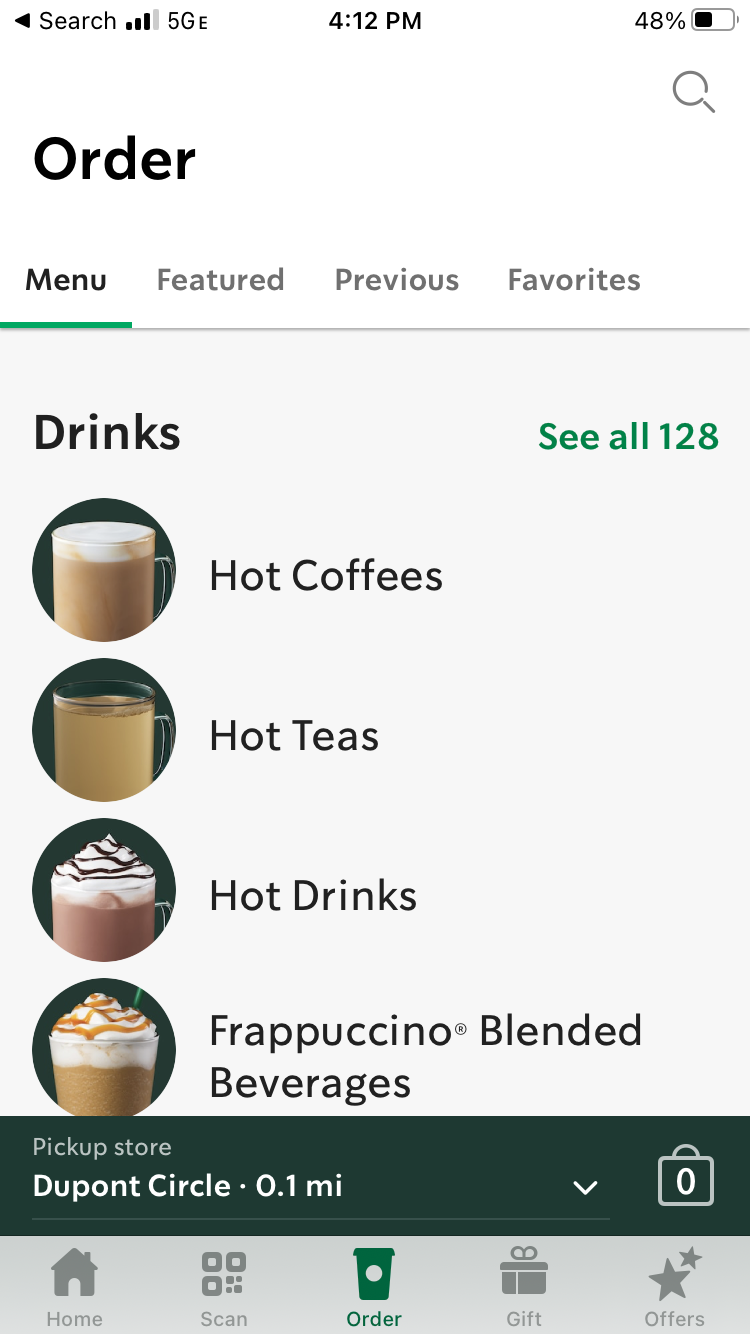
Additionally, the Starbucks app is exceptionally innovative because it provides a similar experience to visiting the store . Many of us have stood in line at Starbucks thinking, “I should get a gift card for (insert person/occasion).” The Gift menu brings up a variety of gift cards for nearly every occasion, and even suggests cards for upcoming holidays. Starbucks added the convenience functionality despite the risk of placing too many “bells and whistles” in the app. Chief Digital Officer Adam Brotman acknowledged that the company didn’t “ want the app to become too much of a Swiss Army knife .”
However, the innovative features have been well received and have not overwhelmed users. The Starbucks app provides its users with a personalized experience.
2. Personalization
Starbucks added personalization elements allowing the app to recall your favorite order, suggest what food items might pair well with that order, and where you’d like to pick it up. Again, this simplifies the user experience and makes it especially easy to place an order. It keeps track of what you've ordered in the past and your favorite drinks to ensure that it's easy for users to place their order during their morning commute.
3. Geo-Location
There are Starbucks everywhere, so it's important for users to be able to select which one they wish to visit when they place an order. The app uses geo-location to show where each storefront is located and how close a user is to each one.
Using the geo-location feature, a user can see where the closest Starbucks locations are, the menu at each location, and even place an order that can be ready upon arrival.
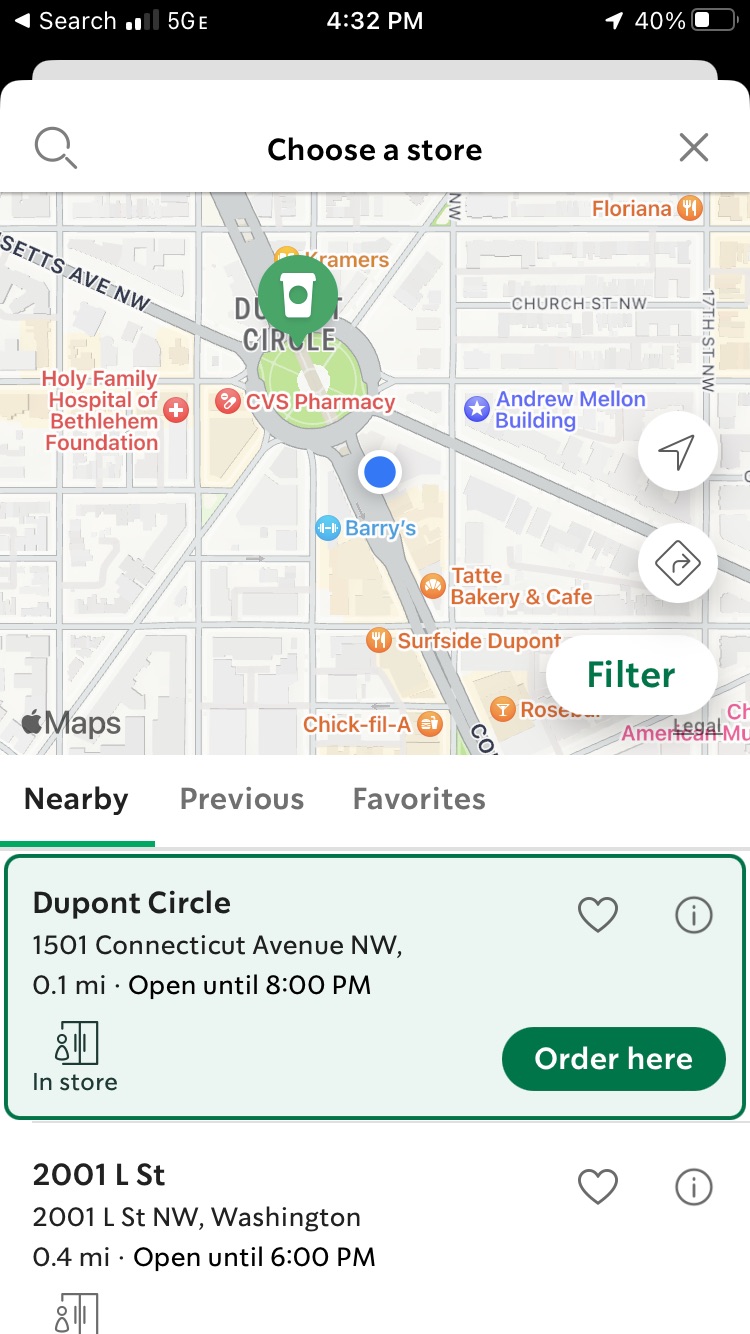
If you often order from a specific location, the app will automatically select that location, limiting the number of clicks a user has to make to place an order.
4. The Starbucks Rewards Loyalty Rewards Program Leads the Competition
The Starbucks Rewards program is a prime example of how to get customers to utilize a mobile app. Simply put, the more you spend at Starbucks, the more rewards points (or “stars”) you earn. Not only is this great for users on the app, but it also helps foster brand loyalty. With the promise of rewards, users are more likely to order from Starbucks in the future.
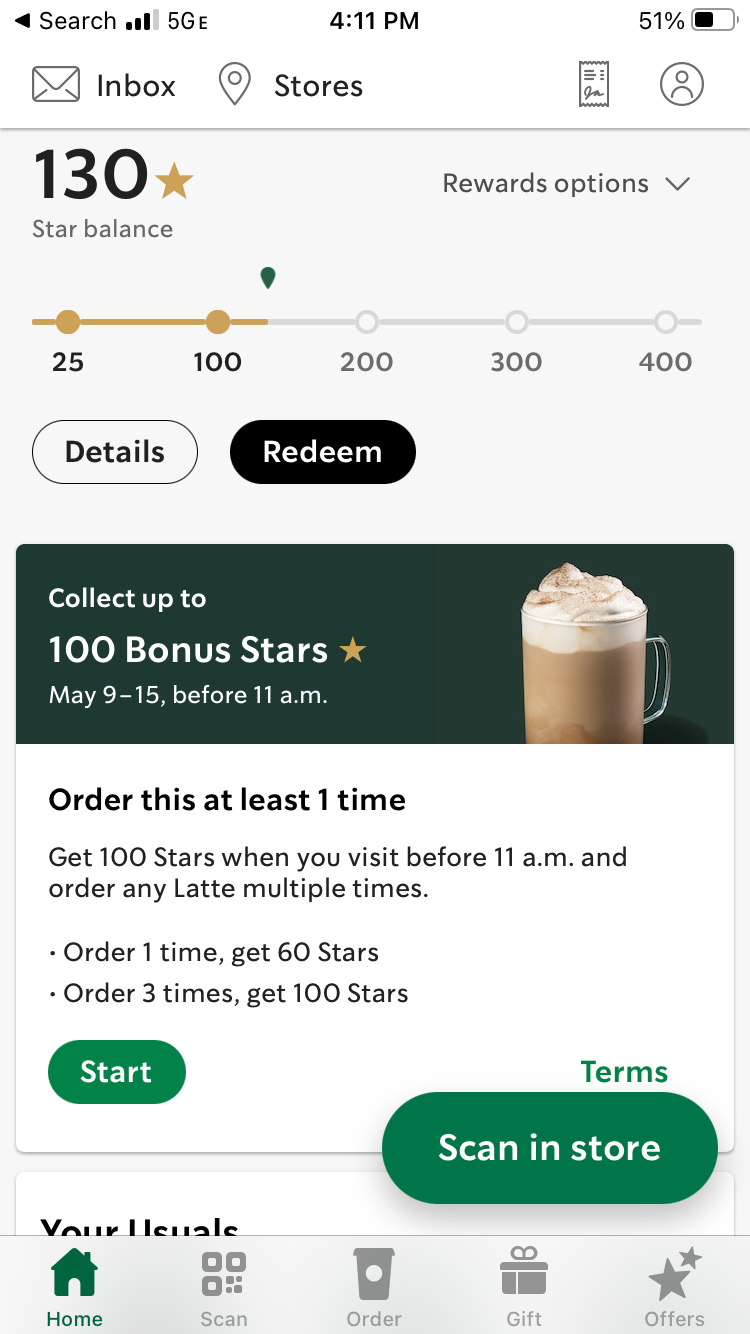
The rewards program gives a number of benefits for app users. In addition to earning two stars for every dollar spent, rewards members get other benefits like free in-store refills, special member offers/events, and the ability to pay by phone and order ahead.
The rewards program also offers plenty of customization for users, including a free beverage on the user’s birthday and personalized suggestions based upon past orders. In return, Starbucks solidifies an instant digital relationship with the 14.2 million active U.S. rewards program members. The loyalty program has seen hefty growth , with an 11% growth in users in Q2 2018. And Starbucks rewards program members in certain places actually spend more, representing 39% of the entire chain’s sales . However, Starbucks recognizes that not all customers want to join the rewards program. Starbucks is planning to ramp up digital interactions by offering mobile order and pay options to all customers—not just rewards members. The company also will take advantage of Wi-Fi sign-ins at various stores to help drive mobile order and pay options. The Starbucks rewards program encourages users to utilize the app to track purchases, as well as the stars earned. To facilitate their usage, stars have a limited shelf life—one year for basic (or “Green”) level rewards customers, and six months for upper-tier (or “Gold) members. The app provides reminders about stars that are expiring, as well as the number of stars needed to maintain Gold status. Gold members also get special double-star days when they earn four stars per $1 spent.

5. Starbucks’ Mobile App Makes Online Ordering and Paying Easy
Since launching the initiatives in 2015, Starbucks has become the standard bearer when it comes to mobile ordering and payments. Mobile Order and Pay is a feature that let customers order via Starbucks’ app and skip the line. At first, the growth of Mobile Order and Pay caused some congestion issues inside stores for customers while picking up their coffee and/or food. As one customer stated, “Why should I order ahead if I just have to stand in line to retrieve my order?”
Starbucks responded by adding dedicated stations for mobile order-ahead customers, distinct from existing in-store registers, and giving baristas new tablets. The mobile ordering system acts as a digital marketing tool, allowing customers to see new items ahead of time. Coupled with notifications from the app or email blasts, Starbucks creates interest in new menu items long before the customer sets foot in the store. Often, these digital tools create a sense of urgency for customers to sample the latest offerings. Starbucks also enabled orders via Amazon's Alexa, and the feature has also been integrated into Ford vehicles. The coffee chain also expanded its My Starbucks barista, a feature integrated into the Starbucks app, which allows customers to order via voice command or messaging. The goal was to boost speed and convenience. In-store payments are also encouraged through the app, which utilizes a Starbucks gift card to process the payments. This creates seamless transactions, as the gift card can be automatically or manually reloaded using a credit card, Apple Pay or Google Pay, or even with the balance from another gift card. The app screen can be scanned at the register to process the payment. For iOS users, the app integrates with the Apple Watch, producing a bar code that also can be scanned for those on the go.
By offering a wide variety of functionalities, Starbucks’ Mobile Order and Pay allows users to order and pay in the way that is most convenient for them – which encourages greater sales.
Starbucks’ App Exemplifies Loyalty App Success
The Starbucks app is the center of the company’s digital ecosystem, bringing together loyalty, mobile payment, and content partnerships, all seamlessly integrated into one convenient application. Restaurants can follow Starbucks’ example to create a successful restaurant loyalty rewards app.
David 'DJ' Oragui
Founder & Lead Growth Engineer at Grow Hack Scale, Balanced Narrative and Balanced Life Academy Group., Grow Hack Scale
Need help selecting a company?
Our team will connect you with a verified company.
Recommended Development articles
Top 7 python frameworks: which one you should choose, empowering startups: integrating ai into your content strategy, how to invest in the metaverse: beginners guide, 7 disruptive technology trends dominating in 2023, hire a top development company.
Mobile App Development Companies
Java Companies
IoT Companies
App Modernization Companies
Software Developers Companies
Application Management and Support Companies
Ruby on Rails Companies
Wearables Companies

Customer management
Starbucks’ customer management case study.
- February 19, 2024

Starbucks, once a single storefront in Seattle, has burgeoned into a global coffee powerhouse, renowned for its quality brews and exceptional customer service. This transformation wasn’t just about expanding its footprint; it centered on mastering customer management —a critical factor in the retail and service sectors.
In industries where experiences and relationships outweigh transactions, Starbucks’ narrative from facing customer management challenges to setting industry benchmarks for customer centricity offers invaluable insights.
This case study delves into the strategies, innovations, and steadfast commitment to customer satisfaction that underscore Starbucks’ evolution into a model of customer management excellence .
Historical Context and Challenges
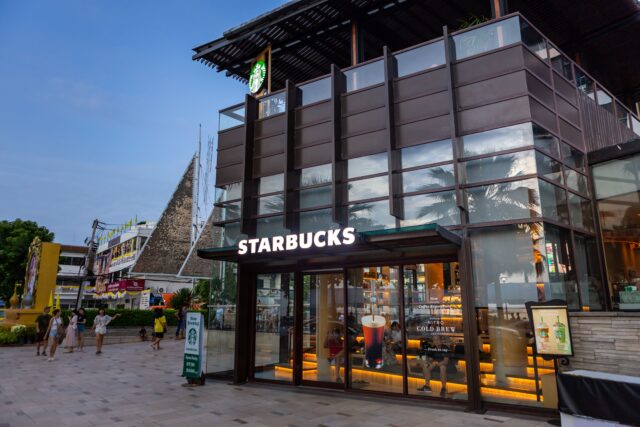
As Starbucks evolved into a global brand, it faced significant customer management challenges that threatened its customer-centric ethos. Initially, Starbucks enjoyed a reputation for intimate customer experiences and high-quality coffee.
However, rapid global expansion and the commodification of the coffee experience began to erode this perception. Specific incidents and trends highlighted the growing pains Starbucks faced in maintaining its customer service standards.
One of the primary challenges was the dilution of the Starbucks experience. As the number of stores increased, Starbucks struggled to maintain the personalized service that had defined its early success. Customers began to report inconsistent service quality, with some locations failing to live up to the company’s high standards.
This inconsistency was a symptom of broader operational challenges, including employee training and retention issues, which directly impacted customer satisfaction.
Customer feedback mechanisms at the time were not as developed, leading to a disconnect between Starbucks and its customer base. The company’s rapid expansion meant it was harder to track customer satisfaction trends effectively and respond to feedback swiftly.
This issue was compounded by the 2008 financial crisis, which saw Starbucks closing several underperforming stores and reevaluating its business strategy amidst declining sales and customer visits.
The broader impact of these challenges on Starbucks’ brand image and financial performance was significant. The perception of Starbucks shifted from a premium coffee experience to a more commoditized one, where the unique selling proposition of Starbucks was less about the customer experience and more about convenience. This shift threatened the core of Starbucks’ brand identity, which was built on customer connections and community.
Financially, the company saw a downturn in its profitability during this period. The financial crisis exacerbated existing problems, leading to a significant restructuring of the company’s operations.
Starbucks’ response to these challenges marked a turning point in its approach to customer management, initiating a series of strategic initiatives aimed at reclaiming its reputation for customer-centricity and operational excellence.
In the next sections, we’ll explore the turning point for Starbucks, the strategic overhaul undertaken to address these challenges, and the innovative approaches that helped Starbucks not only recover but also thrive by refocusing on customer management.
Turning Point

The turning point for Starbucks in prioritizing customer management came during the late 2000s, marked by a series of key events and realizations that led to a fundamental shift in the company’s approach to customer service and overall strategy.
One pivotal moment was the return of Howard Schultz as CEO in 2008 . Schultz, who had stepped down as CEO in 2000, returned to lead the company amid declining sales, store closures, and growing dissatisfaction among customers and employees alike.
Recognizing the urgent need to revitalize the brand and reconnect with customers, Schultz initiated a bold plan to refocus on Starbucks’ core values and customer experience.
Under Schultz’s leadership, Starbucks took several initial steps to address its customer management issues:
- Closing Stores for Barista Training: In a highly symbolic move, Starbucks temporarily closed approximately 7,100 U.S. stores for several hours to conduct a nationwide barista training program. This initiative aimed to reinforce the company’s commitment to coffee quality and customer service excellence.
- Reevaluating Store Expansion Plans: Starbucks reevaluated its aggressive store expansion strategy, recognizing that rapid growth had contributed to the dilution of the customer experience. The company shifted focus towards improving the performance of existing stores and ensuring new locations contributed positively to the brand’s value proposition.
- Enhancing Customer Feedback Mechanisms: Understanding the importance of customer feedback, Starbucks enhanced its mechanisms for gathering and responding to customer insights . This included the launch of “My Starbucks Idea,” a digital platform that allowed customers to submit suggestions for improvements, which the company could then implement.
- Revamping the Starbucks Experience: Schultz emphasized the need to revive the unique Starbucks experience, focusing on the ambiance of the stores, the quality of customer interactions, and the overall environment. This included redesigning stores, improving product offerings, and implementing initiatives aimed at creating a more engaging and personalized customer experience.
These initial steps marked the beginning of Starbucks’ journey toward customer management mastery. By acknowledging its shortcomings and taking decisive action to reconnect with its core values and customers, Starbucks set the stage for a comprehensive strategy overhaul that would ultimately redefine its approach to customer service and set new standards for the industry.
Strategic Overhaul
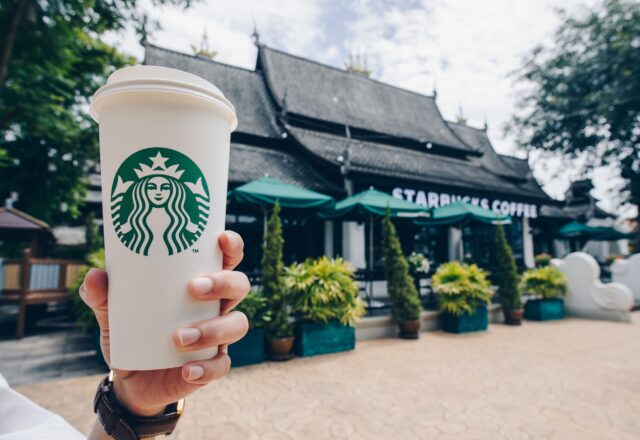
In response to the challenges it faced, Starbucks embarked on a comprehensive strategic overhaul focused on improving customer management. This strategy was multifaceted, addressing various aspects of the business from customer feedback to employee training, technology, and community initiatives.
Customer Feedback and Engagement
Starbucks recognized the critical role of customer feedback in guiding its improvements and rebuilding trust. The introduction of “My Starbucks Idea” was a significant step in integrating customer feedback mechanisms.
This platform allowed customers to submit, vote on, and discuss ideas directly with Starbucks, covering everything from product suggestions to environmental concerns. It democratized innovation and signaled to customers that their opinions were valued, leading to the implementation of numerous customer-generated ideas.
Employee Training and Empowerment
Employee training and empowerment became a cornerstone of Starbucks’ strategy to enhance the customer experience. Following the nationwide barista training program, Starbucks continued to invest heavily in its workforce.
This included not only technical coffee-making skills but also soft skills essential for customer service excellence. Baristas and store managers were empowered to make decisions that would improve customer satisfaction, such as remaking a drink if a customer was not completely satisfied.
This approach underscored the importance of each employee in contributing to the overall customer experience, resulting in a positive outcome on all major customer success metrics .
Technology and Innovation
Starbucks leveraged technology and innovation to improve customer convenience and personalization. The launch of the Starbucks mobile app, including mobile ordering and payment, was a game-changer, significantly reducing wait times and enhancing the customer experience.
The app’s integration with the Starbucks Rewards loyalty program offered personalized offers and recommendations, increasing customer engagement and retention . Through technology, Starbucks was able to offer a more seamless and customized experience to its customers, reinforcing its brand promise of convenience and personalization.
Community and Environmental Initiatives
Understanding the growing consumer demand for responsible and sustainable business practices, Starbucks intensified its community and environmental initiatives. Efforts such as ethically sourcing coffee, reducing waste through the promotion of reusable cups, and investing in local communities helped rebuild trust and loyalty among customers.
These initiatives demonstrated Starbucks’ commitment to corporate social responsibility and its alignment with customers’ values, further enhancing its brand image and customer relationships.
Through this strategic overhaul, Starbucks addressed the root causes of its customer management challenges.
By actively engaging with customers, empowering employees, leveraging technology, and committing to social responsibility, Starbucks not only improved its customer management but also set new standards for excellence in the retail industry.
This comprehensive approach to revitalization has solidified Starbucks’ position as a leader in customer experience, innovation, and community engagement.
Lessons Learned
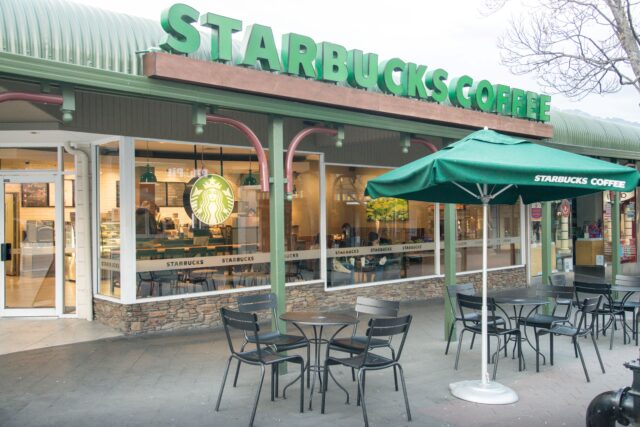
Starbucks’ transformation in customer management offers several key insights and lessons for other companies aiming to enhance their customer engagement and brand reputation. Here are the primary takeaways:
1. Embrace Customer Feedback
Starbucks demonstrated the value of actively listening to and engaging with customers. By implementing platforms like “My Starbucks Idea,” the company not only gathered invaluable insights but also fostered a sense of community and belonging among its customer base.
Lesson: Incorporating customer feedback—this could be through USSD Mobile Surveys offered by a platform like SeVO Poll —into business decisions can lead to innovative solutions and stronger customer loyalty.
2. Invest in Employee Empowerment
The role of baristas and store managers was pivotal in Starbucks’ turnaround. By investing in comprehensive training and empowering employees to make decisions that benefit the customer experience, Starbucks enhanced service quality and consistency.
Lesson: Empowered employees are more engaged and better equipped to deliver exceptional customer service, directly impacting customer satisfaction and loyalty.
3. Leverage Technology for Personalization
Starbucks’ use of mobile apps and loyalty programs to offer personalized experiences and conveniences to customers set a new standard in the retail industry.
Lesson: Technology can be a powerful tool in understanding and catering to individual customer preferences, driving both satisfaction and engagement.
4. Commit to Corporate Social Responsibility
Starbucks’ focus on community and environmental initiatives resonated with customers’ values, rebuilding trust and enhancing loyalty.
Lesson: A genuine commitment to social responsibility can strengthen a brand’s reputation and appeal to consumers’ desire to support ethical and sustainable businesses.
Importance of a Customer-Centric Approach
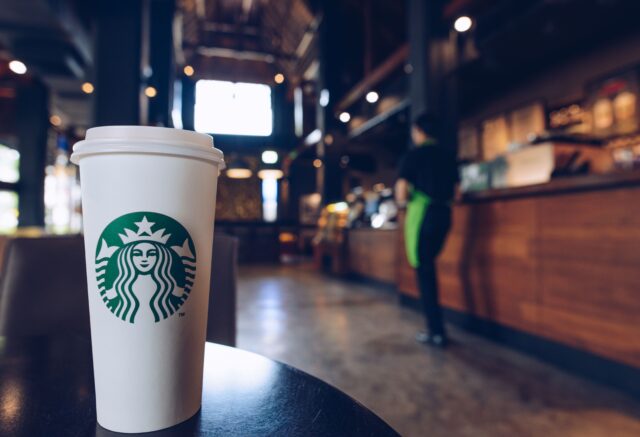
The overarching lesson from Starbucks’ journey is the importance of maintaining a customer-centric approach. This involves continuously seeking ways to understand and meet customer needs, preferences, and values. A customer-centric strategy not only helps in navigating challenges but also in identifying opportunities for growth and innovation.
By prioritizing customer management and adopting a holistic approach to business operations, Starbucks not only navigated through its challenges but also emerged stronger, with a reinforced brand reputation and a loyal customer base.
These lessons underscore the value of integrating customer feedback, empowering employees, leveraging technology, and upholding social responsibility as core elements of a successful customer management strategy.
Key Takeaways
Starbucks’ journey from facing significant customer management challenges to achieving mastery in the field underscores the transformative power of a customer-centric approach.
Through strategic overhauls in feedback mechanisms, employee training and empowerment, technology integration, and commitment to corporate social responsibility, Starbucks not only addressed its immediate challenges but also laid the foundation for sustained success.
This evolution highlights the critical role that effective customer management plays in maintaining a strong brand reputation and fostering deep connections with consumers.
The key to Starbucks’ ongoing success lies in its acknowledgment that customer management is a continuous journey, not a destination. The retail landscape and customer expectations are ever-evolving, demanding constant innovation and adaptation.
Starbucks’ commitment to listening to its customers, empowering its employees, leveraging new technologies for personalization, and upholding its social responsibilities demonstrates a model for other companies to follow.
Reflecting on Starbucks’ experience, it becomes clear that effective customer management is integral to building and maintaining a successful brand. It requires a holistic approach that permeates every aspect of the business, from the frontline employees who interact with customers daily to the strategic decisions made at the corporate level. By placing the customer at the heart of their operations, companies can navigate the complexities of the modern retail environment and achieve enduring success.
Starbucks’ story is a testament to the fact that with the right strategies, challenges in customer management can be transformed into opportunities for growth, innovation, and stronger customer relationships. It serves as a reminder that in the competitive landscape of the retail and service industries, the companies that thrive are those that remain unwaveringly committed to enhancing their customer management practices.

Related aritcles
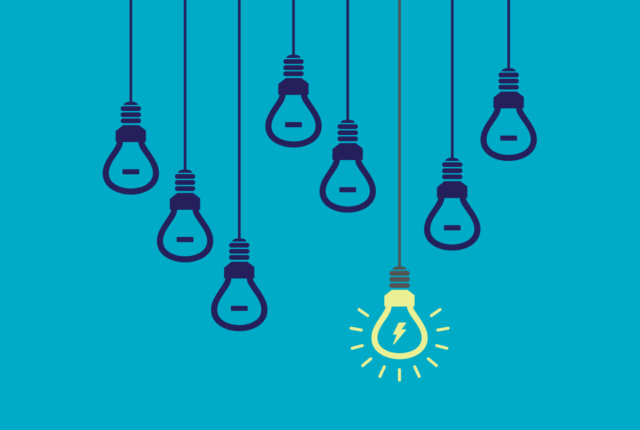
How to Extract Actionable Insights from Customer Data
Welcome to the wild, wonderful world of customer data, where numbers dance, patterns emerge, and
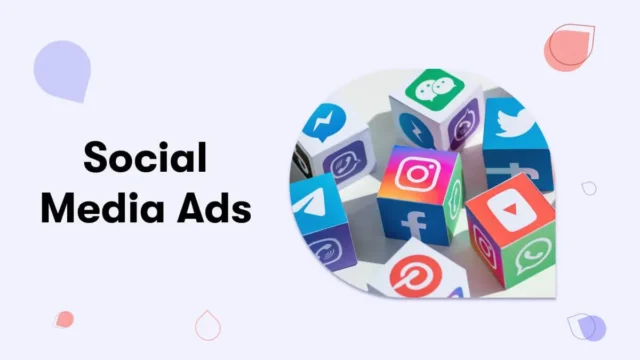
How to Use Social Media Ads for Customer Acquisition
Did you know that 54% of social browsers use social media to research products? Imagine
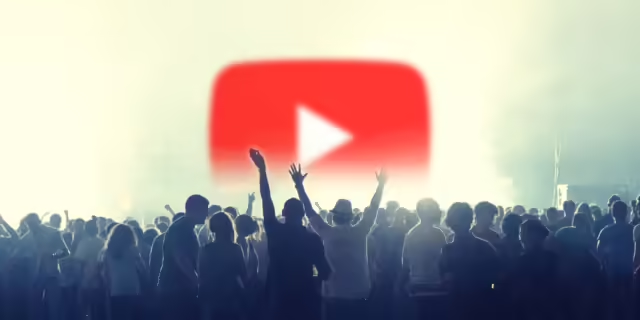
The Ultimate Guide to Starting a YouTube Channel in Ghana
Imagine this: Kwame, a young Ghanaian with a knack for storytelling, started a YouTube channel
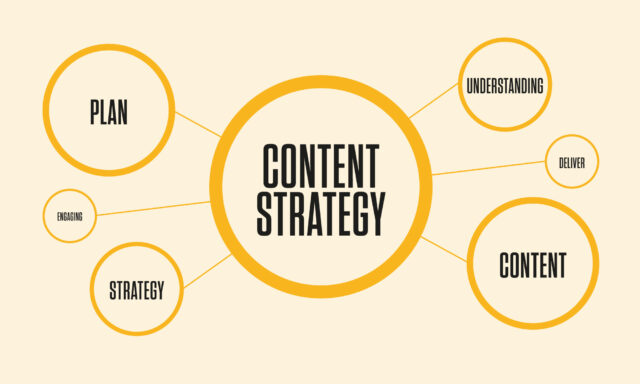
How to Create a Content Strategy for a Ghanaian Audience
Imagine this: you’re scrolling through your phone, bombarded with content from all corners of the

Discover the latest updates
Never miss out on a moment with us., by submitting this form, you indicate that you have read and agreed to gwo sevo's privacy policy, our socials, © 2024 gwo sevo. all rights reserved..
- Customer Acquisition
- Customer Insights
Quick Links
- TXT Connect
Contact Info
- No.71 Swaniker Street Abelenkpe, Accra
- 0531037232 / 0302797680
- [email protected]
Stay in Touch Be the first to know about new job positions.

A Case Study of Starbucks Branding and Customer Loyalty

- News from our partners
Starbucks' Journey to Iconic Status
Creating a culture of customer loyalty.
| Starbucks Rewards Members | xxx million (as of current date) |
| Average Annual Spend per Member | $xxx |
| Frequency of Store Visits | x times per month (on average) |
| Customer Satisfaction Ratings | xx% (based on recent surveys) |
Brand Identity and Consistency
| Logo Design | Green mermaid emblem |
| Store Design | Modern, inviting ambiance |
| Product Packaging | Distinctive Starbucks branding |
| Employee Dress Code | Green aprons with the Starbucks logo |
Innovative Marketing Strategies
| Traditional Advertising | Television commercials, print ads |
| Digital Marketing | Social media campaigns, email marketing |
| Starbucks Mobile App | Mobile ordering, loyalty program |
| Collaborations and Partnerships | Limited edition collaborations with brands |
The Success of Starbucks' Rewards Program
| Total Starbucks Rewards Members | xxx million (as of current date) |
| Percentage of Sales from Rewards | xx% |
| Average Spend per Rewards Member | $xxx |
| Redemption Rate | xx% |
Conclusion:

MORE NEWS STORY
News from our partners.

Neon Signs: Making a Bold Statement

10 Best Online Casino Malaysia: Trusted Casino Sites Of 2024

New Jersey Gambling Revenue is Increasing but Has Still Not Reached Pre-Pandemic Levels in Some Areas
Jersey shore weekend, holiday weekend in ocean city features labor day run and pops concerts, get ready for octc’s musical "seussical jr.", north beach ventnor to host 2nd annual backyard bbq, latest news, last day announced for wonderland pier on ….

Delays Expected on 34th Street Bridge During …

Ocean City Happenings: MS Bike Ride Rolls …

Ocean City Library Reopens; Patrons Excited to …

Ocean City Half Marathon Draws Nearly 1,000 …

Van Drew to Hold Hearing to investigate …

Ventnor City Yardsale Map and List
| S | M | T | W | T | F | S |
|---|---|---|---|---|---|---|
To Submit an Event Sign in first
Today's events.
No calendar events have been scheduled for today.
Subscribe to our Newsletter
- SUGGESTED TOPICS
- The Magazine
- Newsletters
- Managing Yourself
- Managing Teams
- Work-life Balance
- The Big Idea
- Data & Visuals
- Case Selections
- HBR Learning
- Topic Feeds
- Account Settings
- Email Preferences
How Starbucks’s Culture Brings Its Strategy to Life
- Varya Davidson
- Paul Leinwand

They focus on a few positive attributes and amplify them.
In most organizations, culture and strategy tend to be discussed in separate conversations. Executives know that culture is important and that a negative culture can hurt company performance, but they often don’t know what to do about it. Or they attempt to improve the situation by launching a culture initiative to “make the workplace more positive.” What most executive teams typically fail to do is to connect the company’s culture with how the company makes its strategy work.
- Varya Davidson leads the people and organization business for Strategy& in Australia, Southeast Asia, and New Zealand and sits on the Katzenbach Center’s global leadership team. She is a partner with PwC Australia, and has worked with leading public and private sector organizations across Europe, the Middle East, North and South America and Asia-Pacific.
- Paul Leinwand is a principal at PwC U.S., a global managing director at Strategy&, and an adjunct professor at Northwestern’s Kellogg School. He is a coauthor, with Mahadeva Matt Mani, of Beyond Digital: How Great Leaders Transform Their Organizations and Shape the Future (HBR Press, 2022).
Partner Center
- Meta Llama 3.2 launch: Giving AI eyes and a voice to rival OpenAI and Anthropic – Tech Funding News
- Meta Orion AR Glasses: The Next Frontier in Augmented Reality
- Research: Competent Leaders Know The Limits of Their Expertise – HBR.org Daily
- Technology Trends Shaping the Future of Education – Analytics Insight
- OpenAI Executives Exit as C.E.O. Works to Make the Company For-Profit – The New York Times

Case Study: Starbucks’ Success Elevating Customer Experience with Customer Journey Mapping
Customers journey mapping to deliver great customers experiences.

Starbucks, the world-renowned coffee company, is known for its exceptional customer experience and innovative offerings. To stay ahead in the competitive coffee industry and maintain its reputation, Starbucks has consistently prioritized understanding its customers and their needs. One key strategy that Starbucks has used to achieve this is customer journey mapping.
Customer Journey Mapping Strategy
Starbucks embarked on a comprehensive customer journey mapping initiative, aiming to identify pain points in its customers’ experiences and develop solutions to address these issues. The company engaged in a cross-functional approach, involving teams from various departments such as marketing, store operations, and product development, to ensure a holistic understanding of the customer journey.
Understanding the Customer Journey

Starbucks conducted extensive research to gain insights into its customers’ interactions with the brand, both online and offline. The company collected data through customer interviews, surveys, and observations, as well as leveraging digital analytics and transactional data. This information was used to create detailed customer journey maps, highlighting key touchpoints, emotional states, and pain points.
Identifying Pain Points and Opportunities
The customer journey maps revealed several areas where Starbucks could improve its customer experience. Some notable pain points included long wait times, inconsistent product quality, and challenges in navigating the rewards program. The company also identified opportunities to enhance the in-store experience, such as incorporating digital technologies and personalizing customer interactions.
Developing a Customer Experience Roadmap
Armed with these insights, Starbucks developed a customer experience roadmap that outlined the strategic initiatives and improvements needed to address the identified pain points and capitalize on opportunities. Some of the successful implementations based on the roadmap include:
- Mobile Order & Pay: To reduce wait times and streamline the ordering process, Starbucks introduced the Mobile Order & Pay feature in its app. This allowed customers to place orders in advance and pick up their drinks without waiting in line, significantly enhancing the overall customer experience.
- Personalized Rewards: Starbucks revamped its rewards program to make it more accessible and user-friendly, tailoring offers and promotions based on customers’ preferences and purchasing habits. This personalized approach encouraged customer loyalty and increased engagement with the brand.
- Consistent Quality Standards: Starbucks invested in employee training and quality control measures to ensure consistent product quality across all locations. This focus on excellence helped reinforce the brand’s reputation for offering high-quality coffee and beverages.
- Digital Integration: Starbucks introduced digital touchpoints in its stores, such as interactive menu boards and mobile payment options, to create a seamless and engaging customer experience. These innovations helped bridge the gap between the online and offline customer journey.

The company’s attention to the entire journey has been a key factor in the development of the premium coffee category.
According to PeopleMetrics, Starbucks has been able to simplify and operationalize Customer Journey Mapping which has helped them unlock the intersection of convenience and connection by introducing enhancements to the customer experience across retail and digital that meet customers wherever they are, expanding the Third Place experience beyond the physical store.
Initiatives that have been uncovered through journey mapping exercises:
Starbucks is investing in its partners, creating personalized experiences for customers, and innovating its digital and retail strategy.
Investing in Partner Success
Starbucks is placing its partners at the core of its Reinvention plan. The company believes that investing in its partner base is key to delivering high-quality customer experiences, uplifting brand affinity and customer loyalty, and increasing value back to partners through wages, benefits, programming, and tools for continued personal growth. In fiscal 2023, Starbucks has identified a number of near-term solutions that will be implemented to ensure a thriving partner experience:
How to Improve Customer Experience
Wage and Recognition Innovation:
Starbucks is helping partners by giving them the hours they need, expanding digital tipping, and incorporating other opportunities to increase overall pay. The company is committed to paying partners competitively and has raised its starting wage in the U.S. to $15 per hour.
New Well-being Benefits:
Starbucks is offering enhanced sick pay, new savings and student loan management benefits, and additional mental health support to its partners.
Personalized Career Mobility:
Starbucks is introducing a new partner app and the development of personalized career paths to enable its partners to achieve their career goals.
Investments in Store Managers:
Starbucks is providing new leadership trainings, reinventing scheduling and decision-making tools, and creating career journey mapping to improve store manager retention and empower them to focus on core functions of the job that increase satisfaction and overall performance of their store partners.
These investments are aimed at empowering Starbucks partners to thrive at work, thrive as individuals, and thrive together. Stores managed by partners with over three years of tenure have 13% greater weekly sales and higher customer satisfaction, making it clear that investing in partner success is a win-win for both partners and the company.
Creating Personalized Experiences for Customers
Starbucks is committed to unlocking the intersection of convenience and connection by introducing enhancements to the customer experience across retail and digital that meet customers wherever they are, expanding the Third Place experience beyond the physical store. The company is investing in purpose-built store concepts, delivering beverage innovation, and expanding effortless digital convenience to create personalized experiences for its customers.
Investing in Purpose-built Store Concepts:
Starbucks is reimagining the store environment by introducing purpose-built store concepts that meet customers wherever and whenever they want and improve the partner experience. The company is investing an incremental $450M in the existing U.S. store base in fiscal year 2023 with continued investment in fiscal 2024 and 2025. Starbucks expects these investments will create efficiencies, unlock capacity for partners, and enable increased throughput to support increasing customer demand.
Digital and Physical Customer Journey Optimization
Delivering Beverage Innovation:
To improve partner and customer experiences, Starbucks has developed the Siren System, a proprietary new equipment innovation designed to meet the growing demand for customization of hot and cold beverages and warm foods. As part of the Siren System, Starbucks has redesigned its cold beverage station, which significantly reduces the time and number of steps to make cold beverages, unlocking productivity gains and ultimately freeing up time for partners to connect with customers.
In addition, Starbucks is developing a new way of extracting cold coffee and espresso with the Cold Pressed Cold Brew system. This new, proprietary technology delivers cold press coffee in a matter of seconds and in fewer than four steps, a step-change improvement when compared to today’s cold brew which is steeped for 20 hours and takes more than 20 steps to make. The Cold Pressed Cold Brew will begin testing in stores in fiscal 2023.
Expanding effortless digital convenience
Starbucks’ Reinvention Plan aims to create a seamless and personalized experience for customers, making it easier for them to get their favorite Starbucks beverage when and where they want. The company has recognized the increasing importance of digital convenience in providing a better customer experience. The COVID-19 pandemic has also highlighted the need for contactless ordering and payment options. Starbucks has responded by investing in and expanding its digital offerings, such as its mobile ordering platform, Starbucks Rewards program, and Starbucks Delivers.
Growing Starbucks Delivers program with DoorDash and UberEats
One of Starbucks’ major initiatives for expanding digital convenience is growing its Starbucks Delivers program. The company has partnered with DoorDash to expand the program to a national scale alongside UberEats in fiscal 2023. This partnership aims to improve delivery efficiency, expand delivery areas, and offer more delivery options to customers. Starbucks Delivers is expected to be available in over 10,000 stores across the United States by the end of 2022.
Increase Customer Satisfaction with a Digital Customer Experience Platform
Starbucks Rewards program with Starbucks Odyssey
Starbucks is also evolving its Starbucks Rewards program with Starbucks Odyssey, a Web3-enabled experience that will bridge the physical and digital customer experience. Starbucks Odyssey aims to unlock a new generation of experiential benefits for customers. Through Starbucks Odyssey, customers will be able to earn and redeem rewards, access exclusive content, and become part of a digital community built on human connection. Starbucks plans to roll out Starbucks Odyssey to all customers in the United States and Canada by the end of 2022.
The CDO TIMES Bottom Line
Starbucks’ successful application of customer journey mapping demonstrates the value of understanding customers’ experiences for customers, partners and employees and using these insights to drive improvements and innovation. By identifying pain points and opportunities in the customer journey, Starbucks was able to develop a customer experience roadmap that addressed these issues and reinforced its position as a leader in the coffee industry.
Love this article? Embrace the full potential and become an esteemed full access member, experiencing the exhilaration of unlimited access to captivating articles, exclusive non-public content, empowering hands-on guides, and transformative training material. Unleash your true potential today!
Subscribe on LinkedIn : Digital Insider
Become a paid subscriber for unlimited access, exclusive content, no ads: CDO TIMES
In this context, the expertise of CDO TIMES becomes indispensable for organizations striving to stay ahead in the digital transformation journey. Here are some compelling reasons to engage their experts:
- Deep Expertise : CDO TIMES has a team of experts with deep expertise in the field of Digital, Data and AI and its integration into business processes. This knowledge ensures that your organization can leverage digital and AI in the most optimal and innovative ways.
- Strategic Insight : Not only can the CDO TIMES team help develop a Digital & AI strategy, but they can also provide insights into how this strategy fits into your overall business model and objectives. They understand that every business is unique, and so should be its Digital & AI strategy.
- Future-Proofing : With CDO TIMES, organizations can ensure they are future-proofed against rapid technological changes. Their experts stay abreast of the latest AI advancements and can guide your organization to adapt and evolve as the technology does.
- Risk Management : Implementing a Digital & AI strategy is not without its risks. The CDO TIMES can help identify potential pitfalls and develop mitigation strategies, helping you avoid costly mistakes and ensuring a smooth transition.
- Competitive Advantage : Finally, by hiring CDO TIMES experts, you are investing in a competitive advantage. Their expertise can help you speed up your innovation processes, bring products to market faster, and stay ahead of your competitors.
By employing the expertise of CDO TIMES, organizations can navigate the complexities of digital innovation with greater confidence and foresight, setting themselves up for success in the rapidly evolving digital economy. The future is digital, and with CDO TIMES, you’ll be well-equipped to lead in this new frontier.
Do you need help with your digital transformation initiatives? We provide fractional CAIO, CDO, CISO and CIO services, do a Tech Navigator Assessment and we will help you drive results and deliver winning digital and AI strategies for you! Schedule your FREE Tech Navigator Call NOW:
Subscribe now for free and never miss out on digital insights delivered right to your inbox!
Type your email…
Share this:
- The AI Revolution – Chapter 2: Unlock the Power of AI
- The Robotic Revolution: AI and Automation Reshaping the Restaurant and Hospitality Industry
Carsten Krause
I am Carsten Krause, CDO, founder and the driving force behind The CDO TIMES, a premier digital magazine for C-level executives. With a rich background in AI strategy, digital transformation, and cyber security, I bring unparalleled insights and innovative solutions to the forefront. My expertise in data strategy and executive leadership, combined with a commitment to authenticity and continuous learning, positions me as a thought leader dedicated to empowering organizations and individuals to navigate the complexities of the digital age with confidence and agility. The CDO TIMES publishing, events and consulting team also assesses and transforms organizations with actionable roadmaps delivering top line and bottom line improvements. With CDO TIMES consulting, events and learning solutions you can stay future proof leveraging technology thought leadership and executive leadership insights. Contact us at: [email protected] to get in touch.
2 thoughts on “ Case Study: Starbucks’ Success Elevating Customer Experience with Customer Journey Mapping ”
Pingback: The Power of Email Marketing KPIs for Food and Beverage Brands
Pingback: A Guide to Customer Journey Analytics in 2024 and Leveraging Predictive Analytics for Enhanced Customer Insights - 360head digital marketing agency
Leave a Reply Cancel reply
Discover more from the cdo times.
Subscribe now to keep reading and get access to the full archive.
Continue reading
You must be logged in to post a comment.
Starbucks started its international expansion in the mid-1990s. Its first store outside of the USA was opened in Tokyo in 1996. Today, Starbucks is a global leader in the coffee industry, with more than 35,000 stores in 80 countries across the globe. The company generates most of its revenue from the sales of beverages such as lattes, cappuccinos, and frappuccinos.
Digital innovation remains at the core of Starbucks’s strategy, as they introduced mobile ordering and created the Starbucks Rewards program, which comprised approximately 20% of its total sales. Such a focus on technology enhances the convenience and loyalty of the customers.
Marketing Strategy of Starbucks
Starbucks has been excellent in marketing their products due to the following reasons:
The company serves espresso-based drinks, specialty lattes, and seasonal items such as the popular Pumpkin Spice Latte, which is a cultural phenomenon. By 2024, the company offers more than 80 beverage options to satisfy different customer preferences.
Starbucks focuses on ethical sourcing of coffee responsibly and follows Coffee and Farmer Equity (CAFE) Practices to ensure environmental sustainability, social responsibility, and economic fairness. This initiative has won Starbucks great respect among environmentally aware consumers. Its launch of plant-based menu items like the Beyond Meat Breakfast Sandwich illustrates the company’s awareness of changing consumer tastes toward healthier and more sustainable choices. The company also offers ready-to-drink beverages sold at grocery stores, which generate an estimated $1.5 billion in sales.
Starbucks uses a premium pricing strategy to provide its customers with high-quality products and a rich experience. The average price for most of its beverages is within the $3 to $6 range, which is how this brand stakes its claim as a premium coffee retailing option. It appeals to customers willing to pay a premium for high-quality coffee and an enjoyable experience in the coffee shops. Starbucks utilizes the loyalty card, which gives free drinks and personalized offers, which results in repeat sales and further increases customer loyalty.
3. Promotion
Starbucks uses multiple media to run its promotional campaigns. The company spends a tremendous amount on social media, which involves interacting with customers via Instagram, Facebook, and Twitter. It posts visually attractive content that contains its drinks and food products. Today, in 2024, Starbucks has over 40 million followers on Instagram, which provides massive reach and helps Starbucks reach new customers.
Another critical marketing tool is the Starbucks Rewards program, which has over 30 million active members in the US only. Such a program encourages customers to repeat purchases and yields actionable information about preferences that Starbucks deploys to fine-tune its marketing efforts. Private offers, advance previews of new products, and complimentary items that can be redeemed using points all bring customers back for more. Starbucks also organizes events like coffee tasting and community organizing in its stores. Such practices tend to engage customers on a personal level.
4. Advertising
Starbucks has relied on storytelling and emotional appeals rather than aggressive sales pitches. Thematic interventions form the core of brand campaigns that emphasize sustainability, quality, and building a community. For instance, the “Meet Me at Starbucks” campaign focused on authentic stories about connections made at Starbucks locations and underlined the role of the brand in building community.
In 2023, Starbucks spent around $300 million on advertising and promotion, with an increased focus on online marketing. The company uses targeted online advertisements, email marketing, and influencer and celebrity partnerships to reach its target audience. The company publishes interesting blogs and videos that enlighten people on how it sources its coffee and its ethical commitments. Such moves increase the trust of its customers and make them loyal to the brand.
Starbucks’ success story revolves around its strategic focus on product quality, premium pricing, innovative promotion, and engaging advertising. The evolution to meet the changing consumer preferences and an ongoing thrust on sustainability have made Starbucks cultivate a loyal customer base and a significant global presence. As it moves along with changes in the coffee world around it, Starbucks continues to target perfection so that the customer should not just look at the brand as just another coffee company but as a name synonymous with coffee worldwide.
Frequently Asked Questions (FAQs)
When was starbucks established .
Starbucks was established in 1971 in Seattle, Washington. At the time, it was just a single store that sold high-quality coffee beans and equipment.
How many locations does Starbucks have globally?
As of 2024, Starbucks operates more than 35,000 stores in 80 different countries, making it one of the world’s largest coffeehouse chains.
How does Starbucks engage with its customers on social media?
Starbucks interacts very actively with its customers via Instagram, Facebook, and Twitter by posting blogs and videos educating people on its sustainable and ethical practices. Moreover, the company partners with influencers and celebrities to attract new customers.
Who is the CEO of Starbucks?
Brian R. Niccol is the CEO of Starbucks as of 24 September 2024.
Is Starbucks owned by Tata?
Starbucks formed a joint venture with Tata Consumers Products Ltd. in 2012 to start operations in India.
Related Posts

Case Study on Apple Marketing Strategy

Netflix Case Study: Marketing Strategy, Product Portfolio and Pricing Strategy

Nike Case Study: Business Model & Marketing Strategy
Pocketful is an advanced trading platform that empowers traders with cutting-edge technology. we provide innovative tools and resources to make trading more accessible and practical., quick links.
- Open an Account
- Pocketful Web
- Pocketful App
- Investment Tool
- Trading Tool
- Support Portal
- Referral Program
- Calculators
- Stocks Pages
- Government Schemes
- Index Heat Map
- Stock Screener
- Mutual Funds
- Terms & Conditions
- Policies & Procedures
- Privacy Policy
- Press & Media
We are a concern of PACE Group. Pocketful is an investing platform that helps people be better investors. Pocketful unlocks the discoverability of new investment and trading ideas.
Open free demat account.
Join Pocketful Now

You have successfully subscribed to the newsletter
There was an error while trying to send your request. Please try again.

Starbucks Loyalty Rewards Program Case Study: What Makes It Work?
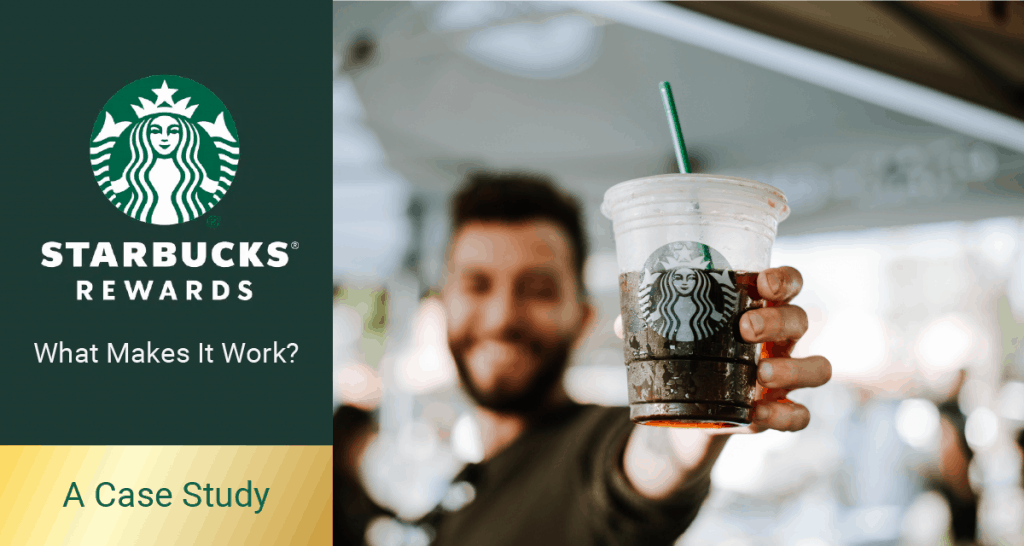
Coffee helps us to kick start our day or helps us take the best breaks when we need one! Coffee gives us the much-needed boost of energy. The coffee market is growing at a CAGR of 5.5% during the forecast period (2019 – 2024). The number of Americans who drink a cup of coffee daily has been the highest in six years. This highlights the massive potential of this market segment. One of the key players in the coffee market is Starbucks, a common name to the coffee cravings! Starbucks has 30,184 stores worldwide, making a consistent coffee experience available in different countries throughout the world.
About Starbucks Loyalty Program:
Starbucks offers one of the most sought-after loyalty programs ‘Starbucks Rewards’ program that offers freebies and discounts to members giving them plenty of reasons to choose Starbucks over other players. ‘Starbucks Rewards’ program represents a significant portion of the coffee chain’s recent fiscal growth. Starbucks has reported an increased revenue of $2.65 billion, attributing their rewards program for most of the increase. Over the last two years, membership has grown more than 25%, loyal customers use Starbucks’ membership program (16 million members) for about 40% of sales at the company’s US stores. Revenue rose 4.6% to $6.31 billion during the quarter from the previous year.
How Does the Starbucks Rewards Program Work?
Starbucks has enabled customers to check their gift card balance, points, and mobile orders via phone, website, in-store, or on their user-friendly app. Real time correspondence of different channels eliminates the possibility of a lapse in communication. This omnichannel capability is attractive to customers, encouraging engagement at many levels. Customers earn birthday rewards, free in-store refills and double-star days- these are limited-time promotions during which members earn twice the points for purchases made.
Experience the Zinrelo Loyalty Rewards Platform to Believe it!
Mobile app makes online ordering and payment easy. The mobile ordering system acts as a digital marketing tool, allowing customers to see new items much in advance of launch. The Starbucks app provides users with an inviting and innovative personalized experience, just like the coffee chain itself. The convenience of using an app acts as a powerful driver of loyalty. The simple layout of the app makes it appealing to users.

Starbucks gathers information on customers habits, interests etc. thus empowering them to offer more relevant perks & communication to customers. According to a survey by Manifest, a technology survey data company in 2018, Starbucks has the most regularly used loyalty rewards app (48%). Launched in 2015, the mobile order and pay feature helped customers to order via the app & skip the line. The app offers customers convenience while clearly communicating how customers can earn rewards points (stars) and what they will get with them. A strong gamification strategy fueled by exclusive customized offers, has helped the brand stay top of mind for customers.
Changes & enhancements to the ‘Starbucks Rewards’ programs are on the leading edge of customer loyalty. They have recently revamped their rewards program in North America to offer occasional customers greater access to freebies. With the aim to provide more flexibility in the program to bring in greater value to more people.
Highlights of New Starbucks Loyalty Program-
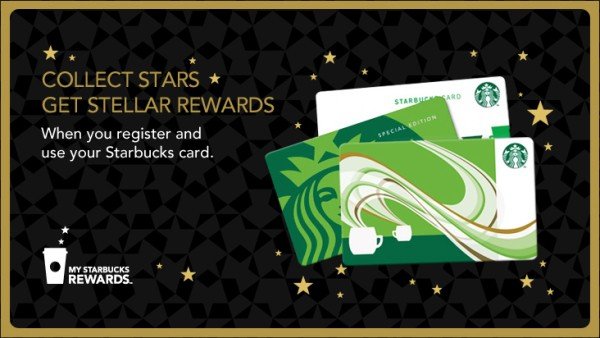
- Customers have multiple benchmarks to cash in their stars for rewards. They can get rewards faster, option to make minor customizations for free in exchange for 25 stars. Some of the most popular rewards like Macchiatos, Starbucks lattes and other drinks will now require 150 stars, an increase from the previous program.
- Members can redeem smaller amounts of stars for lower-value buys
- Starbucks rewards will form a single-level program, where all members can begin to earn stars toward free rewards from the day they join.
- Points will not expire for customers, who attach the loyalty program membership to their Starbucks rewards Visa credit card or a prepaid card. In the previous program, any gold-level points would expire six months after the calendar month they are earned in.
- When a customer walks in a Starbucks store, any purchase they make can be used towards rewards.
Starbucks used to give a free drink of customers choice after $62.50 in spend; now, customer must spend $75. Customers were upset with this change, as there were initial hiccups in the communication of the new program benefits. However, Starbucks was fast to address customer concerns on social media.
What has Not Changed in the Starbucks Program?
- Free Starbucks birthday drink, this could be a complimentary handcrafted beverage, or one complimentary ready-to-drink bottled beverage or one complimentary food item.
- Opportunity to earn bonus stars on monthly double stars days.
How do the Rewards Work in the New Program?
New redemption options:.
- 25 stars: an espresso shot, dairy substitute, or additional flavor
- 50 stars: brewed hot coffee, hot tea, or bakery item
- 150 stars: handcrafted drink, hot breakfast, or parfait
- 200 stars: lunch sandwich, protein box, or salad
- 400 stars: select merchandise or at-home coffee
The move to revamp the program is to offer customers more flexibility and options.
Starbucks is continuously revamping its loyalty program to offer more value to customers. Further enhancements will help make the program more enjoyable to customers.
Share this post:
About author.
Samir Palnitkar , is the VP of Customer Success at Zinrelo, An expert on building and growing “retention-first” businesses, he frequently writes on customer retention and rewards programs. Samir holds five technology patents, and is the author of two technical books.
More blog posts by Samir Palnitkar

COMMENTS
Starbucks Rewards is often regarded as one of the best retail loyalty programs in existence and one of the most engaged among its members. According to a CNN report, by October 2022, there were 28.7 million active Starbucks reward members. Giving Starbucks a 16% year-over-year growth in its loyalty program. They have created a loyal following ...
Learn from our library of loyalty program case studies. By incentivizing preloaded payments, Starbucks receives cash in advance, improving its cash flow while maximizing brand loyalty at the same time. Customers commit themselves financially to future purchases at Starbucks, which effectively guarantees loyalty and repeat business.
The Starbucks Reward Loyalty Program has a staggering 16 million active members (as of March 2019), with 11% growth of their user base in Q2 2018. Starbucks attributes 40% of its total sales to the Rewards Program and has seen same store sales rise by 7%. The Reward Program is available on mobile devices as the Starbucks app, and has seen ...
brand loyalty because consumers affect a brand's success. Brand loyalty is the bottom. line for companies because repeat purchasing leads to higher sales volume that helps. the company grow (Giddens, 2010). When a product is deemed to have value, consumers are less price conscious. regarding the brand.
That prepaid sum is up over 50% from 2019 levels and itself nearly covers Starbucks combined FY2021 and FY2022 capital expenditures. Starbucks CFO Rachel Ruggeri detailed, "Capital expenditures ...
By July 2015, 20% of Starbucks' payments in the United States came through its mobile app. The company had created a tool to both drive loyalty and grow its customer base. No stranger to innovation, Starbucks was partnering with iTunes as early as 2007, earned its first mobile marketer of the year award by 2010, introduced its mobile app in 2011, and by 2015, 94% of Facebook users were either ...
This research paper delves into the critical relationship between Starbucks sustainable marketing practices and its impact on brand loyalty. The case description of Starbucks as a leading global ...
By July 2015, 20% of Starbucks's payments in the United States came through its mobile app. The company had created a tool to both drive loyalty and grow its customer base. No stranger to innovation, Starbucks was partnering with iTunes as early as 2007, earned its first mobile marketer of the year award by 2010, introduced its mobile app in ...
This Starbucks case study delves into its innovative marketing techniques, digital strategy, and recent campaigns, showcasing why it remains a market leader. ... The Starbucks Rewards program is a loyalty program where customers earn points (stars) for purchases, which can be redeemed for free drinks and food items, along with personalised ...
Refreshers, Evolution Fresh, La Boulange and Verismo. Starbucks had total revenue of $14.89 billion as of September 29th, 2013.2 2) External Environment Of The Retail Market For Coffee & Snacks: 2.1) Industry Overview and Analysis: Starbucks primarily operates and competes in the retail coffee and snacks store industry. This industry
This case study will look at the design of the app, its features, and the bold moves that the coffee chain has made to make the app a "must have" for consumers. Updated May 12, 2023. A recent study found that Starbucks has the most regularly used loyalty rewards app (48%) among a list of major restaurant chains.
This case study delves into the strategies, innovations, ... The app's integration with the Starbucks Rewards loyalty program offered personalized offers and recommendations, increasing customer engagement and retention. Through technology, Starbucks was able to offer a more seamless and customized experience to its customers, reinforcing its ...
This case study explores Starbucks's remarkable journey, tracing the evolution of its brand identity and the cultivation of a fiercely loyal customer base. From its humble beginnings in Seattle to its global expansion, the Starbucks company has meticulously crafted a brand that transcends mere coffee becoming a lifestyle.
Paul Leinwand is a principal at PwC U.S., a global managing director at Strategy&, and an adjunct professor at Northwestern's Kellogg School. He is a coauthor, with Mahadeva Matt Mani, of Beyond ...
Case Study: Starbucks' Success Elevating Customer Experience with Customer Journey Mapping May 9, 2023 May 9, ... uplifting brand affinity and customer loyalty, and increasing value back to partners through wages, benefits, programming, and tools for continued personal growth. In fiscal 2023, Starbucks has identified a number of near-term ...
The foundations of loyalty program, store satisfaction and brand loyalty were assessed using a validated questionnaire. A total of 200 respondents of Starbucks' millennial customers participated ...
Digital innovation remains at the core of Starbucks's strategy, as they introduced mobile ordering and created the Starbucks Rewards program, which comprised approximately 20% of its total sales. Such a focus on technology enhances the convenience and loyalty of the customers.
Starbucks has reported an increased revenue of $2.65 billion, attributing their rewards program for most of the increase. Over the last two years, membership has grown more than 25%, loyal customers use Starbucks' membership program (16 million members) for about 40% of sales at the company's US stores.
In December of 2021, nineteen employees at a Starbucks store in Buffalo, New York voted to unionize, setting off a wave of Starbucks worker organizing unlike anything we've seen in recent times. Created with Sketch Beta. Renew Your ABA Membership It's time to renew your membership and keep access to free CLE, valuable publications and more. ...